VAS 22 BLACK
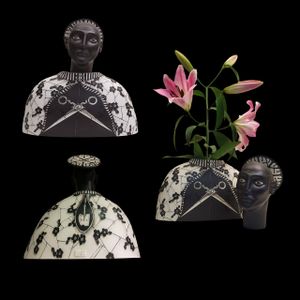
Elica Studio > Styling
VAS 22 BLACK Material Porcelain, engobes, glaze Finishing Matte Sizes (cm) 44 X 19 X 53 Weight (g) 2500 Designed in 2022 Collection Anatomika Lead Time: 30 days Description: The VAS22 BLACK, a striking and conceptually rich piece from the Totemica Collection, is an exceptional work of fine porcelain artistry designed to make a bold statement in any sophisticated interior. This captivating sculpture, was meticulously designed in 2022. Its aesthetic is dominated by a deep, luxurious matte black glaze, which serves as a dramatic canvas for intricate white ink-style illustrations. These illustrations, reminiscent of delicate floral motifs or intricate patterns, wrap around the base of the head and the shoulders, while a more abstract, almost schematic representation of facial features emerges from the dark surface. The integrated opening at the top allows it to function as a unique and striking vase, making it an invaluable asset for interior designers seeking to combine sculptural drama with practical elegance. For interior designers, the VAS22 BLACK offers unparalleled versatility and aesthetic impact. The powerful contrast between the matte black surface and the crisp white illustrations creates a visual tension that immediately draws the eye and exudes contemporary sophistication. This sculpture is ideally suited for spaces that aim for a dramatic, moody, or minimalist aesthetic, where its dark presence can ground a room and add an element of artistic intrigue. Imagine it as a central focal point on a light-colored, minimalist console table in a modern living room, where its stark contrast creates a striking visual anchor. In a high-end commercial space, such as a luxury boutique, a contemporary art gallery, or a chic restaurant, the VAS22 BLACK can serve as a powerful statement piece, reinforcing a brand's commitment to bold design and artistic flair. Its dual functionality as both a sculpture and a vase further enhances its utility, allowing designers to dynamically introduce fresh florals or botanical elements, softening its dark aesthetic and adding an organic touch. The artistic inspiration behind the Totemica Collection, and specifically the VAS22 BLACK, explores themes of darkness and light, negative space, and the subtle emergence of form from shadow. The white ink illustrations can be interpreted as intricate lacework, organic patterns, or even symbolic representations, inviting contemplation and personal interpretation. This conceptual depth provides interior designers with a compelling narrative to integrate into their projects, allowing them to craft environments that are not only visually pleasing but also intellectually stimulating and emotionally resonant. For residential projects, this piece can elevate a study, bedroom, or dining area, fostering an atmosphere of sophisticated elegance and artistic appreciation. In commercial environments, it can contribute to a unique and memorable brand identity, attracting discerning clientele who appreciate bespoke craftsmanship and a daring aesthetic. Practical considerations are well-addressed by the VAS22 BLACK. Crafted from durable fine porcelain, it ensures longevity and maintains its exquisite appearance over time, making it a sustainable and enduring investment. The matte black glaze is elegant and easy to maintain, while the white ink-style illustrations are permanently fixed, ensuring their vibrant details endure. A lead time of 30 days allows for efficient project planning and seamless integration into design schedules. Its stable weight and balanced dimensions make it suitable for various placements, from prominent display on a central table to a subtle yet impactful accent within a curated display case. The ability to use it as a vase adds significant functional value, enhancing its appeal for designers looking for multi-purpose art. In conclusion, the VAS22 BLACK from the Totemica Collection is far more than a decorative item; it is a profound artistic statement and a highly versatile design tool capable of transforming interiors into dynamic, sophisticated, and aesthetically rich environments. Its unique blend of artistic drama, functional elegance, and high-quality craftsmanship makes it an indispensable resource for interior designers committed to crafting truly distinctive and inspiring spaces for their discerning clientele.
VAS22 – BAROCCO
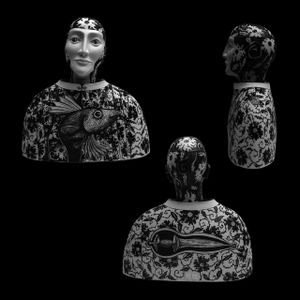
Elica Studio > Styling
VAS22 – BAROCCO Material Porcelain, engobes, oxides, glaze Finishing Matte Sizes (cm) 44 X 19 X 53 Weight (g) 2500 Designed in 2023 Collection Anatomika Lead Time: 30 days Description: The VAS22 BAROCCO, a profoundly artistic and functionally elegant piece from the Totemica Collection, is an exceptional work of fine porcelain designed to imbue interiors with a sense of dramatic flair and intricate beauty. This captivating sculpture was meticulously designed in 2022. Its aesthetic is defined by a deep, luxurious matte black glaze, which serves as a striking backdrop for an elaborate white ink-style illustration. This illustration sweeps across the face and shoulders in a manner reminiscent of classical Baroque ornamentation, yet rendered with a modern, graphic sensibility. The integrated opening at the top allows it to function as a unique and striking vase, making it an invaluable asset for interior designers seeking to combine sculptural drama with practical elegance and a touch of historical grandeur. For interior designers, the VAS22 BAROCCO offers unparalleled versatility and aesthetic impact. The powerful contrast between the sophisticated matte black surface and the delicate, flowing white patterns creates a visual tension that immediately draws the eye and exudes contemporary sophistication. This sculpture is ideally suited for spaces that aim for a dramatic, moody, or opulent aesthetic, where its dark presence can ground a room and add an element of artistic intrigue. Imagine it as a central focal point on a light-colored, minimalist console table in a modern living room, where its stark contrast creates a striking visual anchor. Alternatively, in a more traditional or eclectic setting, its Baroque-inspired motifs can harmoniously blend with existing ornate elements, providing a modern interpretation of classical grandeur. In a high-end commercial space, such as a luxury boutique, a contemporary art gallery, or a chic restaurant, the VAS22 BAROCCO can serve as a powerful statement piece, reinforcing a brand's commitment to bold design, artistic flair, and a curated sense of history. Its dual functionality as both a sculpture and a vase further enhances its utility, allowing designers to dynamically introduce fresh florals or botanical elements, softening its dramatic aesthetic and adding an organic touch. The artistic inspiration behind the Totemica Collection, and specifically the VAS22 BAROCCO, delves into the rich decorative traditions of the Baroque era, reinterpreted through a contemporary lens. The white ink illustrations, while echoing the swirling, curvilinear forms of Baroque art, are executed with a graphic precision that feels distinctly modern. This conceptual depth provides interior designers with a compelling narrative to integrate into their projects, allowing them to craft environments that are not only visually pleasing but also intellectually stimulating and emotionally resonant. For residential projects, this piece can elevate a study, dining area, or master bedroom, fostering an atmosphere of cultured elegance and artistic appreciation. In commercial environments, it can contribute to a unique and memorable brand identity, attracting discerning clientele who appreciate bespoke craftsmanship and a daring aesthetic that bridges eras. Practical considerations are well-addressed by the VAS22 BAROCCO. Crafted from durable fine porcelain, it ensures longevity and maintains its exquisite appearance over time, making it a sustainable and enduring investment. The matte black glaze is elegant and easy to maintain, while the white ink-style illustrations are permanently fixed, ensuring their intricate details endure. A lead time of 30 days allows for efficient project planning and seamless integration into design schedules. Its stable weight and balanced dimensions make it suitable for various placements, from prominent display on a central table to a subtle yet impactful accent within a curated display case. The ability to use it as a vase adds significant functional value, enhancing its appeal for designers looking for multi-purpose art that adapts to evolving design narratives. In conclusion, the VAS22 BAROCCO from the Totemica Collection is far more than a decorative item; it is a profound artistic statement and a highly versatile design tool capable of transforming interiors into dynamic, sophisticated, and aesthetically rich environments. Its unique blend of artistic drama, functional elegance, and high-quality craftsmanship makes it an indispensable resource for interior designers committed to crafting truly distinctive and inspiring spaces for their discerning clientele.
SYS 22 HAND
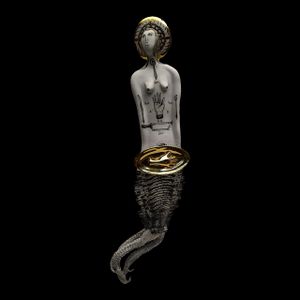
Elica Studio > Styling
SYS 22 HAND Material Porcelain, engobes, oxides, glaze, 24 k gold Finishing Matte and glossy Sizes (cm) 12 X 50 Weight (g) 800 Designed in 2022 Collection Anatomika Lead Time: 30 days Description: The VAS22 BAROCCO, a profoundly artistic and functionally elegant piece from the Totemica Collection, is an exceptional work of fine porcelain designed to imbue interiors with a sense of dramatic flair and intricate beauty. This captivating sculpture was meticulously designed in 2022. Its aesthetic is defined by a deep, luxurious matte black glaze, which serves as a striking backdrop for an elaborate white ink-style illustration. This illustration sweeps across the face and shoulders in a manner reminiscent of classical Baroque ornamentation, yet rendered with a modern, graphic sensibility. The integrated opening at the top allows it to function as a unique and striking vase, making it an invaluable asset for interior designers seeking to combine sculptural drama with practical elegance and a touch of historical grandeur. For interior designers, the VAS22 BAROCCO offers unparalleled versatility and aesthetic impact. The powerful contrast between the sophisticated matte black surface and the delicate, flowing white patterns creates a visual tension that immediately draws the eye and exudes contemporary sophistication. This sculpture is ideally suited for spaces that aim for a dramatic, moody, or opulent aesthetic, where its dark presence can ground a room and add an element of artistic intrigue. Imagine it as a central focal point on a light-colored, minimalist console table in a modern living room, where its stark contrast creates a striking visual anchor. Alternatively, in a more traditional or eclectic setting, its Baroque-inspired motifs can harmoniously blend with existing ornate elements, providing a modern interpretation of classical grandeur. In a high-end commercial space, such as a luxury boutique, a contemporary art gallery, or a chic restaurant, the VAS22 BAROCCO can serve as a powerful statement piece, reinforcing a brand's commitment to bold design, artistic flair, and a curated sense of history. Its dual functionality as both a sculpture and a vase further enhances its utility, allowing designers to dynamically introduce fresh florals or botanical elements, softening its dramatic aesthetic and adding an organic touch. The artistic inspiration behind the Totemica Collection, and specifically the VAS22 BAROCCO, delves into the rich decorative traditions of the Baroque era, reinterpreted through a contemporary lens. The white ink illustrations, while echoing the swirling, curvilinear forms of Baroque art, are executed with a graphic precision that feels distinctly modern. This conceptual depth provides interior designers with a compelling narrative to integrate into their projects, allowing them to craft environments that are not only visually pleasing but also intellectually stimulating and emotionally resonant. For residential projects, this piece can elevate a study, dining area, or master bedroom, fostering an atmosphere of cultured elegance and artistic appreciation. In commercial environments, it can contribute to a unique and memorable brand identity, attracting discerning clientele who appreciate bespoke craftsmanship and a daring aesthetic that bridges eras. Practical considerations are well-addressed by the VAS22 BAROCCO. Crafted from durable fine porcelain, it ensures longevity and maintains its exquisite appearance over time, making it a sustainable and enduring investment. The matte black glaze is elegant and easy to maintain, while the white ink-style illustrations are permanently fixed, ensuring their intricate details endure. A lead time of 30 days allows for efficient project planning and seamless integration into design schedules. Its stable weight and balanced dimensions make it suitable for various placements, from prominent display on a central table to a subtle yet impactful accent within a curated display case. The ability to use it as a vase adds significant functional value, enhancing its appeal for designers looking for multi-purpose art that adapts to evolving design narratives. In conclusion, the VAS22 BAROCCO from the Totemica Collection is far more than a decorative item; it is a profound artistic statement and a highly versatile design tool capable of transforming interiors into dynamic, sophisticated, and aesthetically rich environments. Its unique blend of artistic drama, functional elegance, and high-quality craftsmanship makes it an indispensable resource for interior designers committed to crafting truly distinctive and inspiring spaces for their discerning clientele.
SYS 22 VAGINA
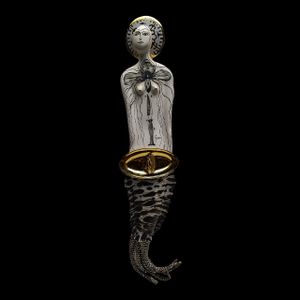
Elica Studio > Styling
SYS 22 VAGINA Material Porcelain, engobes, oxides, glaze, 24 k gold Finishing Matte and glossy Sizes (cm) 12 X 50 Weight (g) 800 Designed in 2022 Collection Anatomika Lead Time: 30 days Description: The SYS22 VAGINA, a strikingly powerful and conceptually profound piece from the Systema Collection, is an exceptional work of fine porcelain artistry designed to challenge perceptions and elevate interiors with its bold symbolism and intricate details. Its aesthetic is defined by a serene matte white glazed body, adorned with precise black ink-style illustrations reminiscent of anatomical diagrams, ancient glyphs, or esoteric symbols. The most captivating elements are the lustrous gold-plated details: a distinctive top element suggesting a halo or a crown, and a central gold-plated motif that hints at the feminine form, echoing the collection's name. This piece offers interior designers an unparalleled opportunity to introduce a sophisticated blend of artistic expression, symbolic depth, and opulent detail into their projects. For interior designers, the SYS22 VAGINA is an exceptionally versatile and impactful design element that demands attention and encourages deep contemplation. The elongated, almost columnar form, suggestive of a sacred or scientific artifact, provides a unique vertical presence that can anchor a space or serve as a compelling focal point. The juxtaposition of the pure, anatomical white porcelain with the precise black illustrations and the opulent gold accents creates a dynamic visual narrative. This sculpture is ideally suited for spaces that aim to evoke a sense of intellectual curiosity, artistic deconstruction, or a refined modern aesthetic with a philosophical edge. Imagine it prominently displayed in a sleek, minimalist home library, where its symbolic illustrations can inspire thought, or commanding attention in a high-end corporate office with a focus on innovation and progressive thought. In an art gallery, a cultural institution, or a private collection, the SYS22 VAGINA can symbolize creation, life, strength, or the celebration of the feminine, aligning with spaces that value intellectual depth and cutting-edge design. The artistic inspiration behind the Systema Collection, and particularly the VAGINA design, delves into the systematic understanding of the human body and universal principles, often exploring themes of life, fertility, and the inherent power within creation. The anatomical drawings, the symbolic representations, and the overall structured yet artistic presentation suggest a meticulous exploration of form and function, both biological and abstract. This rich thematic tapestry provides interior designers with a compelling narrative to integrate into their projects, allowing them to craft environments that are not only visually stunning but also intellectually stimulating and emotionally resonant. For residential projects, this sculpture can elevate a study, a refined living area, or a bespoke collection, fostering an atmosphere of cultured elegance and artistic appreciation. In commercial environments, it can contribute to a unique and memorable brand identity, attracting clientele who appreciate bespoke craftsmanship and a design that challenges and inspires. Practical considerations are well-addressed by the SYS22 VAGINA. Crafted from durable fine porcelain, it ensures longevity and maintains its exquisite appearance over time, making it a sustainable and enduring investment. The matte white glaze is elegant and easy to maintain, while the black ink-style illustrations are permanently fixed, ensuring their intricate details endure. The gold-plated elements are expertly applied for lasting brilliance and resistance to tarnishing. A lead time of 30 days allows for efficient project planning and seamless integration into design schedules. Its substantial weight and balanced dimensions ensure stability, making it suitable for various placements, from prominent display on a central pedestal to a commanding presence in a curated vignette. The multi-faceted visual appeal, combining symbolic meaning with aesthetic beauty, ensures it remains a captivating presence. In conclusion, the SYS22 VAGINA from the Systema Collection is far more than a decorative item; it is a profound artistic statement and a versatile design tool capable of transforming interiors into dynamic, sophisticated, and intellectually stimulating environments. Its unique blend of intriguing symbolism, refined craftsmanship, and bold design, combined with high-quality materials and thoughtful execution, makes it an indispensable resource for interior designers committed to crafting truly distinctive and inspiring spaces for their discerning clientele.
SYS 22 HEAD

Elica Studio > Styling
SYS 22 HEAD Material Porcelain, engobes, oxides, glaze, 24 k gold Finishing Matte and glossy Sizes (cm) 12 X 50 Weight (g) 800 Designed in 2022 Collection Anatomika Lead Time: 30 days Description: The SYS22 HEAD, a conceptually rich and visually striking piece from the Syrante Collection, is a remarkable work of fine porcelain artistry designed to introduce a profound layer of intellectual depth and artistic intrigue into sophisticated interiors. Its aesthetic is defined by a serene matte white glazed body, featuring delicate yet precise black ink-style illustrations that hint at anatomical outlines, internal structures, or abstract patterns across the torso. The most captivating element is the lustrous gold-plated halo or crown that encircles the head, adding a touch of opulent sanctity or elevated thought. This piece offers interior designers an unparalleled opportunity to introduce a sophisticated blend of scientific inquiry, artistic expression, and opulent detail into their projects. For interior designers, the SYS22 HEAD is an exceptionally versatile and impactful design element that commands attention and encourages deep contemplation. The elongated, almost columnar form, suggestive of a figure or a symbolic pillar, provides a unique vertical presence that can anchor a space or serve as a compelling focal point. The juxtaposition of the pure, anatomical white porcelain with the precise black illustrations and the opulent gold halo creates a dynamic visual narrative. This sculpture is ideally suited for spaces that aim to evoke a sense of intellectual curiosity, artistic deconstruction, or a refined modern aesthetic with a philosophical edge. Imagine it prominently displayed in a sleek, minimalist home library, where its diagrammatic illustrations can inspire thought, or commanding attention in a high-end corporate office with a focus on innovation and human insight. In an art gallery, a philosophical institution, or a university setting, the SYS22 HEAD can symbolize wisdom, enlightenment, or the systematic exploration of the human condition, aligning with environments that value intellectual depth and cutting-edge design. The artistic inspiration behind the Syrante Collection, and particularly the HEAD design, delves into the systematic understanding of the human body, mind, and spirit, often exploring themes of perception, knowledge, and inner workings. The subtle anatomical hints combined with the abstract patterns and the symbolic halo elevate the piece beyond mere decoration into a realm of profound commentary. This rich thematic tapestry provides interior designers with a compelling narrative to integrate into their projects, allowing them to craft environments that are not only visually stunning but also intellectually stimulating and emotionally resonant. For residential projects, this sculpture can elevate a study, a refined living area, or a bespoke collection, fostering an atmosphere of cultured elegance and artistic appreciation. In commercial environments, it can contribute to a unique and memorable brand identity, attracting clientele who appreciate bespoke craftsmanship and a design that challenges and inspires. Practical considerations are well-addressed by the SYS22 HEAD. Crafted from durable fine porcelain, it ensures longevity and maintains its exquisite appearance over time, making it a sustainable and enduring investment. The matte white glaze is elegant and easy to maintain, while the black ink-style illustrations are permanently fixed, ensuring their intricate details endure. The gold-plated halo is expertly applied for lasting brilliance and resistance to tarnishing, adding a touch of unparalleled luxury. A lead time of 30 days allows for efficient project planning and seamless integration into design schedules. Its substantial weight and balanced dimensions ensure stability, making it suitable for various placements, from prominent display on a central pedestal to a commanding presence in a curated vignette. The multi-faceted visual appeal, combining symbolic meaning with aesthetic beauty, ensures it remains a captivating presence. In conclusion, the SYS22 HEAD from the Syrante Collection is far more than a decorative item; it is a profound artistic statement and a versatile design tool capable of transforming interiors into dynamic, sophisticated, and intellectually stimulating environments. Its unique blend of intriguing symbolism, refined craftsmanship, and bold design, combined with high-quality materials and thoughtful execution, makes it an indispensable resource for interior designers committed to crafting truly distinctive and inspiring spaces for their discerning clientele.
SYS 22 BREAST
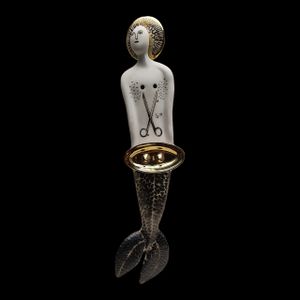
Elica Studio > Styling
SYS 22 BREAST Material Porcelain, engobes, oxides, glaze, 24 k gold Finishing Matte and glossy Sizes (cm) 12 X 50 Weight (g) 800 Designed in 2022 Collection Anatomika Lead Time: 30 days Description: The SYS22 BREAST, an evocative and conceptually rich piece from the Systema Collection, is a remarkable work of fine porcelain artistry designed to introduce a profound layer of intellectual depth and artistic intrigue into sophisticated interiors. Its aesthetic is defined by a serene matte white glazed body, featuring delicate yet precise black ink-style illustrations that hint at anatomical outlines, internal structures, or abstract patterns across the torso. The most captivating element is the lustrous gold-plated halo or crown that encircles the head, adding a touch of opulent sanctity or elevated thought. Additionally, there's a prominent illustration of scissors on the torso. This piece offers interior designers an unparalleled opportunity to introduce a sophisticated blend of scientific inquiry, artistic expression, and opulent detail into their projects. For interior designers, the SYS22 BREAST is an exceptionally versatile and impactful design element that commands attention and encourages deep contemplation. The elongated, almost columnar form, suggestive of a figure or a symbolic pillar, provides a unique vertical presence that can anchor a space or serve as a compelling focal point. The juxtaposition of the pure, anatomical white porcelain with the precise black illustrations and the opulent gold halo creates a dynamic visual narrative. This sculpture is ideally suited for spaces that aim to evoke a sense of intellectual curiosity, artistic deconstruction, or a refined modern aesthetic with a philosophical edge. Imagine it prominently displayed in a sleek, minimalist home library, where its diagrammatic illustrations can inspire thought, or commanding attention in a high-end corporate office with a focus on innovation and human insight. In an art gallery, a philosophical institution, or a university setting, the SYS22 BREAST can symbolize wisdom, enlightenment, or the systematic exploration of the human condition, aligning with environments that value intellectual depth and cutting-edge design. The artistic inspiration behind the Systema Collection, and particularly the BREAST design, delves into the systematic understanding of the human body, mind, and spirit, often exploring themes of perception, knowledge, and inner workings. The subtle anatomical hints combined with the abstract patterns and the symbolic halo elevate the piece beyond mere decoration into a realm of profound commentary. This rich thematic tapestry provides interior designers with a compelling narrative to integrate into their projects, allowing them to craft environments that are not only visually stunning but also intellectually stimulating and emotionally resonant. For residential projects, this sculpture can elevate a study, a refined living area, or a bespoke collection, fostering an atmosphere of cultured elegance and artistic appreciation. In commercial environments, it can contribute to a unique and memorable brand identity, attracting clientele who appreciate bespoke craftsmanship and a design that challenges and inspires. Practical considerations are well-addressed by the SYS22 BREAST. Crafted from durable fine porcelain, it ensures longevity and maintains its exquisite appearance over time, making it a sustainable and enduring investment. The matte white glaze is elegant and easy to maintain, while the black ink-style illustrations are permanently fixed, ensuring their intricate details endure. The gold-plated halo is expertly applied for lasting brilliance and resistance to tarnishing, adding a touch of unparalleled luxury. A lead time of 30 days allows for efficient project planning and seamless integration into design schedules. Its substantial weight and balanced dimensions ensure stability, making it suitable for various placements, from prominent display on a central pedestal to a commanding presence in a curated vignette. The multi-faceted visual appeal, combining symbolic meaning with aesthetic beauty, ensures it remains a captivating presence. In conclusion, the SYS22 BREAST from the Systema Collection is far more than a decorative item; it is a profound artistic statement and a versatile design tool capable of transforming interiors into dynamic, sophisticated, and intellectually stimulating environments. Its unique blend of intriguing symbolism, refined craftsmanship, and bold design, combined with high-quality materials and thoughtful execution, makes it an indispensable resource for interior designers committed to crafting truly distinctive and inspiring spaces for their discerning clientele.
TOTEM VASE VTT25 (2 elements)
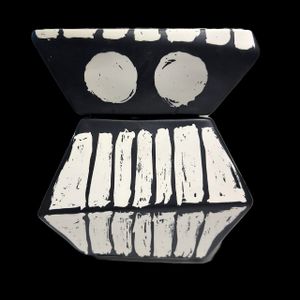
Elica Studio > Styling
Name: TOTEM VASE VTT25 2 ELEMENTS Material: Fine porcelain Finishing: Matte white glaze with hand-painted black ink-style illustrations and gold-plated elements Sizes (cm): Approx. 31 x 23x 35 (height varies) Weight (g): ~6000 Designed in: 2025 Collection: Naturalia Lead Time: 30 days Description: The TOTEM VASE VTT25 2 ELEMENTS, a captivating and conceptually profound piece from the Systema Collection, is an exceptional work of fine porcelain artistry designed to introduce intellectual depth and artistic intrigue into sophisticated interiors. This elongated sculpture, measuring approximately 50 cm in height (with slight variations depending on its base form), 18 cm in width, and 15 cm in depth, and weighing around 2000g, was meticulously designed in 2022. Its striking aesthetic is defined by a serene matte white glazed body, adorned with precise black ink-style illustrations reminiscent of anatomical diagrams or ancient glyphs. The most captivating elements are the lustrous gold-plated accents: a distinctive top element suggesting a halo or a crown, and a central gold-plated disc (which also appears to be a bowl). This piece offers interior designers an unparalleled opportunity to introduce a sophisticated blend of scientific inquiry, artistic expression, and opulent detail into their projects. For interior designers, the TOTEM VASE VTT25 2 ELEMENTS is an exceptionally versatile and impactful design element that demands attention and encourages deep contemplation. The elongated, almost columnar form, suggestive of a sacred or scientific artifact, provides a unique vertical presence that can anchor a space or serve as a compelling focal point. The juxtaposition of the pure, anatomical white porcelain with the precise black illustrations and the opulent gold accents creates a dynamic visual narrative. This sculpture is ideally suited for spaces that aim to evoke a sense of intellectual curiosity, artistic deconstruction, or a refined modern aesthetic with a philosophical edge. Imagine it prominently displayed in a sleek, minimalist home library, where its symbolic illustrations can inspire thought, or commanding attention in a high-end corporate office with a focus on innovation and progressive thought. In an art gallery, a cultural institution, or a private collection, the TOTEM VASE VTT25 2 ELEMENTS can symbolize the pursuit of knowledge, the intricacies of the human body, or the fusion of science and art, aligning with spaces that value intellectual depth and cutting-edge design. The artistic inspiration behind the Systema Collection, and particularly the VTT25 2 ELEMENTS design, delves into the systematic understanding of the human body and universal principles, often exploring themes of life, fertility, and the inherent power within creation. The anatomical drawings, the symbolic representations, and the overall structured yet artistic presentation suggest a meticulous exploration of form and function, both biological and abstract. This rich thematic tapestry provides interior designers with a compelling narrative to integrate into their projects, allowing them to craft environments that are not only visually stunning but also intellectually stimulating and emotionally resonant. For residential projects, this sculpture can elevate a study, a refined living area, or a bespoke collection, fostering an atmosphere of cultured elegance and artistic appreciation. In commercial environments, it can contribute to a unique and memorable brand identity, attracting clientele who appreciate bespoke craftsmanship and a design that challenges and inspires. Practical considerations are well-addressed by the TOTEM VASE VTT25 2 ELEMENTS. Crafted from durable fine porcelain, it ensures longevity and maintains its exquisite appearance over time, making it a sustainable and enduring investment. The matte white glaze is elegant and easy to maintain, while the black ink-style illustrations are permanently fixed, ensuring their intricate details endure. The gold-plated elements are expertly applied for lasting brilliance and resistance to tarnishing. A lead time of 30 days allows for efficient project planning and seamless integration into design schedules. Its substantial weight and balanced dimensions ensure stability, making it suitable for various placements, from prominent display on a central pedestal to a commanding presence in a curated vignette. The multi-faceted visual appeal, combining symbolic meaning with aesthetic beauty, ensures it remains a captivating presence.
TOTEM TTO25 (7 elements)
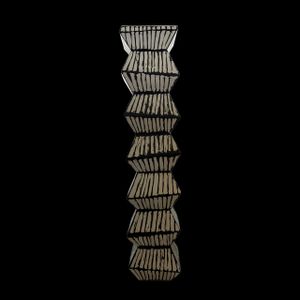
Elica Studio > Styling
Name: TOTEM TTO25 7 ELEMENTS Material: Fine porcelain Finishing: Matte white glaze with hand-painted black ink-style illustrations and gold-plated elements Sizes (cm): Approx. 32 x 23 x 151 (height varies) Weight (g): ~30000 Designed in: 2025 Collection: Naturalia Lead Time: 30 days Description: The TOTEM TTO25 7 ELEMENTS, a visually stunning and deeply symbolic piece from the Systema Collection, is an exceptional work of fine porcelain artistry designed to introduce intellectual depth and artistic intrigue into sophisticated interiors. This elongated sculpture, measuring approximately 50 cm in height (with slight variations depending on its base form), 18 cm in width, and 15 cm in depth, and weighing around 2000g, was meticulously designed in 2022. Its striking aesthetic is defined by a serene matte white glazed body, adorned with precise black ink-style illustrations reminiscent of anatomical diagrams or ancient glyphs, particularly featuring representations of breasts, eyes, teeth, and other biological or symbolic elements. The most captivating elements are the lustrous gold-plated accents: a distinctive top element suggesting a halo or a crown, and a central gold-plated disc (which also appears to be a bowl), which often contains symbolic representations or miniature elements related to the overall theme. This piece offers interior designers an unparalleled opportunity to introduce a sophisticated blend of scientific inquiry, artistic expression, and opulent detail into their projects. For interior designers, the TOTEM TTO25 7 ELEMENTS is an exceptionally versatile and impactful design element that demands attention and encourages deep contemplation. The elongated, columnar form, suggestive of a sacred or scientific artifact, provides a unique vertical presence that can anchor a space or serve as a compelling focal point. The juxtaposition of the pure, anatomical white porcelain with the precise black illustrations and the opulent gold accents creates a dynamic visual narrative. This sculpture is ideally suited for spaces that aim to evoke a sense of intellectual curiosity, artistic deconstruction, or a refined modern aesthetic with a philosophical edge. Imagine it prominently displayed in a sleek, minimalist home library, where its symbolic illustrations can inspire thought, or commanding attention in a high-end corporate office with a focus on innovation and progressive thought. In an art gallery, a cultural institution, or a private collection, the TOTEM TTO25 7 ELEMENTS can symbolize the interconnectedness of systems, the multifaceted nature of human existence, or the fusion of science and art, aligning with spaces that value intellectual depth and cutting-edge design. The artistic inspiration behind the Systema Collection, and particularly the TTO25 7 ELEMENTS design, delves into the systematic understanding of the human body and universal principles, often exploring themes of life, fertility, perception, and the inherent power within creation. The combination of various anatomical or symbolic drawings, and the overall structured yet artistic presentation suggest a meticulous exploration of form and function, both biological and abstract. This rich thematic tapestry provides interior designers with a compelling narrative to integrate into their projects, allowing them to craft environments that are not only visually stunning but also intellectually stimulating and emotionally resonant. For residential projects, this sculpture can elevate a study, a refined living area, or a bespoke collection, fostering an atmosphere of cultured elegance and artistic appreciation. In commercial environments, it can contribute to a unique and memorable brand identity, attracting clientele who appreciate bespoke craftsmanship and a design that challenges and inspires. Practical considerations are well-addressed by the TOTEM TTO25 7 ELEMENTS. Crafted from durable fine porcelain, it ensures longevity and maintains its exquisite appearance over time, making it a sustainable and enduring investment. The matte white glaze is elegant and easy to maintain, while the black ink-style illustrations are permanently fixed, ensuring their intricate details endure. The gold-plated elements are expertly applied for lasting brilliance and resistance to tarnishing. A lead time of 30 days allows for efficient project planning and seamless integration into design schedules. Its substantial weight and balanced dimensions ensure stability, making it suitable for various placements, from prominent display on a central pedestal to a commanding presence in a curated vignette. The multi-faceted visual appeal, combining symbolic meaning with aesthetic beauty, ensures it remains a captivating presence.
BEGONIAS
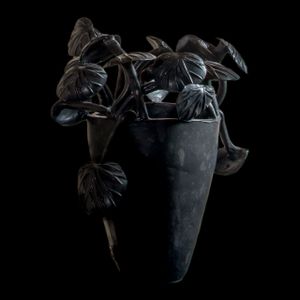
Elica Studio > Styling
Name: EGONIAS Material: Stoneware, engobes, oxides, glaze Finishing: Matte Sizes (cm): Approx. 26 (diameter/width) × 40 (height) Weight (g): ~4000 Designed in: 2015 Collection: Naturalia Lead Time: 30 days Description: The EGONIAS, a captivating and richly textured sculpture from Elica Studio's celebrated "Naturalia" collection, offers a unique blend of organic inspiration and refined artistry, meticulously designed to enrich sophisticated interior spaces. Created in 2015, this piece is more than a decorative item; it is a testament to the enduring beauty of botanical forms, reinterpreted through a contemporary lens, making it an exceptional addition for interior designers seeking to infuse projects with natural elegance and artistic depth. Crafted from robust stoneware, the EGONIAS boasts a distinctive dual aesthetic, seamlessly merging a structured base with a profusion of organic forms. The main body of the sculpture is likely characterized by a clean, elegant silhouette, potentially adorned with subtle textures or patterns that enhance its foundational appeal. The entire piece is treated with a matte finish, achieved through the expert application of engobes, oxides, and glaze. This refined surface treatment absorbs light beautifully, highlighting the intricate details and tactile qualities of the stoneware, creating a warm, inviting presence. The defining feature of the EGONIAS, consistent with its botanical name, lies in its meticulously sculpted elements that evoke lush, cascading foliage, reminiscent of begonia leaves. These organic forms are rendered with exquisite detail, showcasing lifelike veins and naturalistic contours, giving them an almost living quality. The use of oxides within the material likely contributes to varied green or earthy tones in these leafy elements, enhancing their naturalistic appeal and creating a beautiful contrast with the vase's base. This harmonious interplay between the structured vessel and the fluid, abundant foliage creates a dynamic composition that is both visually striking and profoundly serene. The versatility of the EGONIAS is a significant asset for interior designers. It introduces a vibrant touch of nature and sculptural form into any setting, whether it's a minimalist space needing an organic focal point or a richly layered interior seeking an artisanal accent. Its connection to the "Naturalia" collection emphasizes its inspiration from the natural world, allowing it to seamlessly integrate into biophilic design themes, bringing the tranquility and beauty of the outdoors inside. With dimensions of approximately 26 cm in width (or diameter) and a notable 40 cm in height, and weighing a substantial 4000 grams, the EGONIAS possesses a commanding yet balanced presence. Its robust nature and versatile size make it an ideal centerpiece for a dining table, a distinctive accent on a large console in an entryway, or a curated addition to a sophisticated lounge area or high-end commercial space. The deliberate design, rooted in 2015, ensures its timeless appeal, affirming its sustained relevance in contemporary interiors. For interior designers seeking to imbue their projects with unique character, a sense of lush vitality, and a profound artistic sensibility, the EGONIAS is an unparalleled choice. Its intricate details, substantial form, and refined finish position it as an investment piece that will resonate with clients who appreciate bespoke quality, enduring design, and a connection to the artistry of nature. With a standard lead time of 30 days, incorporating this exceptional sculpture into project timelines is straightforward, promising to deliver a profound visual and textural experience that enhances the overall ambiance of any sophisticated interior.
ROSIS
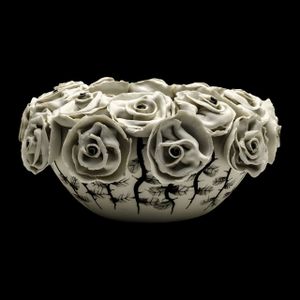
Elica Studio > Styling
Name: ROSIS Material: Porcelain, glaze, oxides Finishing: Matte Sizes (cm): Approx. 34 (diameter) × 16 (height) Weight (g): ~4300 Designed in: 2016 Collection: Naturalia Lead Time: 30 days Description: The ROSIS centerpiece, an exquisitely crafted and deeply evocative piece from Elica Studio's celebrated "Naturalia" collection, offers a profound artistic interpretation of the timeless rose, imbued with both delicate beauty and a captivating underlying strength. Designed in 2016, this unique object transcends conventional decor, serving as a powerful sculptural element that brings a sense of refined artistry, natural elegance, and subtle drama to any interior. It is an ideal choice for interior designers seeking to infuse spaces with a blend of classic floral charm, contemporary conceptual depth, and an undeniable artistic presence. Masterfully crafted from fine porcelain, the ROSIS centerpiece is characterized by its rich textural contrasts and monochromatic palette. The entire piece is finished with a sophisticated matte coating, achieved through the expert application of glazes and oxides, which lends it an understated elegance and a soft, tactile appeal. As vividly illustrated in the accompanying image, the centerpiece takes the form of a broad, shallow bowl. What truly defines this creation is the breathtaking three-dimensional sculpting of numerous white roses that encircle and crown its entire rim, forming a lush, continuous garland of blooms. Each rose is meticulously rendered with intricate details, from the delicate layering of petals to the subtle undulations that give them a lifelike quality. These sculpted white roses stand in striking contrast to the body of the bowl, which is adorned with bold, hand-drawn or applied patterns of dark, thorny vines. These black thorny motifs crawl up from the base of the bowl, reaching towards the pristine white roses, creating a powerful visual tension between beauty and danger, fragility and resilience. This deliberate juxtaposition of the delicate, soft roses and the stark, sharp thorns speaks to the complex nature of beauty itself, making the piece not just decorative but deeply symbolic. The monochromatic scheme further accentuates the forms and textures, allowing the artistic narrative to take center stage. The ROSIS centerpiece, with its unique blend of classical floral motifs, symbolic contrasts, and exquisite sculptural form, offers remarkable versatility for interior designers. It can serve as a stunning standalone art piece, commanding attention on a dining table, a grand console, or a prominent pedestal. Its substantial weight of approximately 4300 grams and generous dimensions of 34 cm in diameter and 16 cm in height ensure an impressive presence in any luxury setting. While its design makes it primarily a decorative object, its profound artistic statement allows it to anchor a room or complement a curated collection of art. Its aesthetic is particularly well-suited for adding a touch of sophisticated naturalism to minimalist interiors, enhancing a romantic or art-deco inspired space, or serving as a conversation starter in a modern, avant-garde setting. Belonging to the "Naturalia" collection, it connects to the raw, untamed beauty of the natural world, interpreted through a lens of refined artistry. Designed in 2016, the ROSIS centerpiece showcases Elica Studio's innovative approach to ceramic art, ensuring its relevance in today's design landscape. For interior designers seeking to imbue their projects with unique character, a sense of refined artistry, and a touch of engaging conceptual depth, the ROSIS centerpiece is an unparalleled choice. Its distinctive aesthetic, thoughtful integration of form and symbolism, and captivating visual impact position it as an investment piece that will resonate with clients who appreciate bespoke quality, enduring design, and a connection to the artistic exploration of nature's profound and multifaceted beauty. With a standard lead time of 30 days, incorporating this exceptional sculpture into project timelines is straightforward, promising to deliver a compelling visual experience that enhances the overall ambiance of any sophisticated interior.
BLACK ROSIS
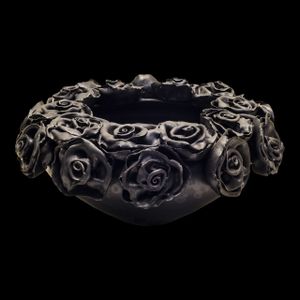
Elica Studio > Styling
Name: BLACK ROSIS Material: Porcelain, glaze Finishing: Matte Sizes (cm): Approx. 34 (diameter) × 16 (height) Weight (g): ~4500 Designed in: 2020 Collection: Naturalia Lead Time: 30 days Description: The BLACK ROSIS centerpiece, a dramatically striking and profoundly evocative piece from Elica Studio's celebrated "Naturalia" collection, offers a captivating artistic interpretation of the rose, rendered in a powerful, monochromatic palette. Designed in 2020, this unique object transcends conventional decor, serving as a commanding sculptural element that brings a sense of refined artistry, sophisticated darkness, and undeniable artistic presence to any interior. It is an ideal choice for interior designers seeking to infuse spaces with a blend of gothic elegance, contemporary conceptual depth, and a compelling statement of natural beauty re-imagined. Masterfully crafted from fine porcelain, the BLACK ROSIS centerpiece is characterized by its rich textural contrasts and deep, uniform color. The entire piece is finished with a sophisticated matte glaze, which lends it an understated elegance and a soft, non-reflective appeal that absorbs light, creating a sense of depth and mystery. As vividly illustrated in the accompanying image, the centerpiece takes the form of a broad, shallow bowl. What truly defines this creation is the breathtaking three-dimensional sculpting of numerous black roses that encircle and crown its entire rim, forming a lush, continuous garland of blooms. Each rose is meticulously rendered with intricate details, from the delicate layering of petals to the subtle undulations that give them a lifelike quality, despite their dark hue. The sculptural roses, along with the body of the bowl, are uniformly black, creating a powerful, singular aesthetic. This monochromatic presentation enhances the forms and textures, allowing the intricate details of the roses to emerge through shadow and light, rather than color. The absence of contrasting patterns, unlike its white counterpart, imbues the BLACK ROSIS with a raw, unadulterated power and a minimalist yet impactful presence. This design speaks to a darker, more mysterious side of nature's beauty, evoking feelings of deep passion, sophisticated drama, or quiet contemplation. The BLACK ROSIS centerpiece, with its unique blend of classical floral motifs, stark monochromatic design, and exquisite sculptural form, offers remarkable versatility for interior designers. It can serve as a stunning standalone art piece, commanding attention on a dining table, a grand console, or a prominent pedestal. Its substantial weight of approximately 4500 grams and generous dimensions of 34 cm in diameter and 16 cm in height ensure an impressive presence in any luxury setting. While its design makes it primarily a decorative object, its profound artistic statement allows it to anchor a room or complement a curated collection of contemporary art. Its aesthetic is particularly well-suited for adding a touch of sophisticated drama to minimalist interiors, enhancing a modern gothic or industrial-chic space, or serving as a conversation starter in an avant-garde setting. Belonging to the "Naturalia" collection, it connects to the raw, untamed beauty of the natural world, interpreted through a lens of profound artistry and contemporary design. Designed in 2020, the BLACK ROSIS centerpiece showcases Elica Studio's innovative approach to ceramic art, ensuring its relevance in today's design landscape. For interior designers seeking to imbue their projects with unique character, a sense of refined artistry, and a touch of engaging conceptual depth, the BLACK ROSIS centerpiece is an unparalleled choice. Its distinctive aesthetic, thoughtful integration of form and symbolism, and captivating visual impact position it as an investment piece that will resonate with clients who appreciate bespoke quality, enduring design, and a connection to the artistic exploration of nature's multifaceted and often powerful beauty. With a standard lead time of 30 days, incorporating this exceptional sculpture into project timelines is straightforward, promising to deliver a compelling visual experience that enhances the overall ambiance of any sophisticated interior.
CRG21
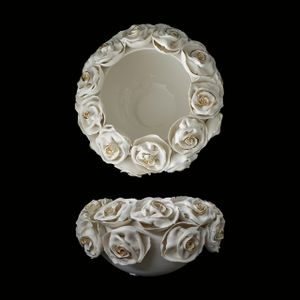
Elica Studio > Styling
Name: CRG21 Material: Porcelain, glaze, 24K gold Finishing: Matte and glossy Sizes (cm): Approx. 34 (diameter) × 14 (height) Weight (g): ~3300 Designed in: 2021 Collection: Naturalia Lead Time: 30 days Description: The CRG21 centerpiece, an exquisitely luxurious and profoundly artistic piece from Elica Studio's celebrated "Naturalia" collection, offers a captivating interpretation of the timeless rose, elevated with the opulence of 24K gold. Designed in 2021, this unique object transcends conventional decor, serving as a commanding sculptural element that brings a sense of refined artistry, natural elegance, and undeniable artistic presence to any interior. It is an ideal choice for interior designers seeking to infuse spaces with a blend of classic floral charm, contemporary conceptual depth, and a radiant touch of precious metal. Masterfully crafted from fine porcelain, the CRG21 centerpiece is characterized by its rich textural contrasts and the interplay of its sophisticated finishes. The main body of the piece appears to be finished with a luxurious matte glaze, which lends it an understated elegance and a soft, tactile appeal that beautifully contrasts with its dazzling accents. As vividly illustrated in the accompanying image, the centerpiece takes the form of a broad, shallow bowl. What truly defines this creation is the breathtaking three-dimensional sculpting of numerous white roses that encircle and crown its entire rim, forming a lush, continuous garland of blooms. Each rose is meticulously rendered with intricate details, from the delicate layering of petals to the subtle undulations that give them a lifelike quality. These sculpted white roses are dramatically accentuated by the prominent incorporation of 24K gold, which gleams within the heart of each bloom. This application of gold, likely a glossy finish, provides a striking contrast to the matte porcelain, creating a dynamic interplay of textures and reflectivity. The warmth and shimmer of the gold not only highlight the exquisite craftsmanship of each rose but also elevate the piece to an object of true luxury and refined taste. This deliberate fusion of natural beauty with precious material speaks to a sophisticated aesthetic that values both organic forms and opulent details. The CRG21 centerpiece, with its unique blend of classical floral motifs, precious metal accents, and exquisite sculptural form, offers remarkable versatility for interior designers. It can serve as a stunning standalone art piece, commanding attention on a dining table, a grand console, or a prominent pedestal. Its substantial weight of approximately 3300 grams and generous dimensions of 34 cm in diameter and 14 cm in height ensure an impressive presence in any luxury setting. While its design makes it primarily a decorative object, its profound artistic statement allows it to anchor a room or complement a curated collection of art. Its aesthetic is particularly well-suited for adding a touch of opulent naturalism to minimalist interiors, enhancing a classic or romantic space, or serving as a conversation starter in a modern, elegant setting. Belonging to the "Naturalia" collection, it connects to the raw, untamed beauty of the natural world, interpreted through a lens of profound artistry and luxurious embellishment. Designed in 2021, the CRG21 centerpiece showcases Elica Studio's innovative approach to ceramic art, ensuring its relevance in today's design landscape. For interior designers seeking to imbue their projects with unique character, a sense of refined artistry, and a touch of engaging conceptual depth, the CRG21 centerpiece is an unparalleled choice. Its distinctive aesthetic, thoughtful integration of form and material, and captivating visual impact position it as an investment piece that will resonate with clients who appreciate bespoke quality, enduring design, and a connection to the artistic exploration of nature's profound and multifaceted beauty. With a standard lead time of 30 days, incorporating this exceptional sculpture into project timelines is straightforward, promising to deliver a compelling visual experience that enhances the overall ambiance of any sophisticated interior.
RCR24 – WHITE ROSE
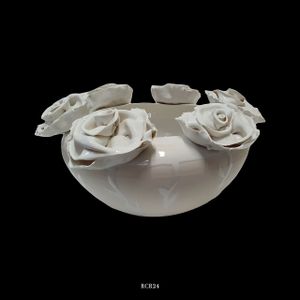
Elica Studio > Styling
Name: RCR24 – WHITE ROSE Material: Porcelain, glaze Finishing: Matte and glossy Sizes (cm): Approx. 30 (diameter) × 30 (diameter) × 17 (height) Weight (g): ~1300 Designed in: 2024 Collection: Naturalia Lead Time: 30 days Description: The RCR24 – WHITE ROSE centerpiece, an exquisitely delicate and timelessly elegant piece from Elica Studio's renowned "Naturalia" collection, offers a pure artistic interpretation of the classic rose. Designed in 2024, this unique object transcends conventional decor, serving as a captivating sculptural element that brings a sense of refined artistry, pristine natural beauty, and subtle sophistication to any interior. It is an ideal choice for interior designers seeking to infuse spaces with understated luxury, a harmonious connection to nature, and an undeniable artistic presence. Masterfully crafted from fine porcelain, the RCR24 – WHITE ROSE centerpiece is characterized by its pure white palette and the intricate interplay of its finishes. The piece features both matte and glossy applications of glaze, creating a subtle yet compelling textural dialogue across its surface. As vividly illustrated in the accompanying image, the centerpiece takes the form of a gracefully rounded, shallow bowl. What truly defines this creation is the breathtaking three-dimensional sculpting of numerous white roses that encircle and adorn its entire rim, forming a lush, ethereal garland of blooms. Each rose is meticulously rendered with intricate details, from the delicate layering of petals to the subtle undulations that give them a lifelike quality. The pristine white of the porcelain highlights the sculptural precision and the inherent beauty of the floral form. The "Matte and glossy" finishing likely translates to a soft, velvety texture on the main body of the bowl, allowing the sculpted roses to perhaps feature more luminous, glossy accents on their petals or within their folds, catching and reflecting light in a subtle dance. This refined interplay of textures enhances the depth and realism of the roses, making them appear almost freshly bloomed. The overall aesthetic is one of serene beauty, clean lines, and an enduring sense of classicism, reinterpreted for contemporary luxury spaces. The RCR24 – WHITE ROSE centerpiece, with its blend of classical floral motifs, sophisticated finishes, and exquisite sculptural form, offers remarkable versatility for interior designers. It can serve as a stunning standalone art piece, commanding attention on a dining table, a console table, or a prominent pedestal. Its lightweight nature, at approximately 1300 grams, combined with its graceful dimensions of 30 cm in diameter and 17 cm in height, makes it an adaptable addition to various luxury settings. While its design makes it primarily a decorative object, its profound artistic statement allows it to anchor a room or complement a curated collection of art. Its aesthetic is particularly well-suited for adding a touch of sophisticated naturalism to minimalist or Scandinavian-inspired interiors, enhancing a romantic or classic space, or serving as a serene focal point in a modern, elegant setting. Belonging to the "Naturalia" collection, it beautifully embodies the essence of nature, interpreted through a lens of refined artistry and timeless design. Designed in 2024, the RCR24 – WHITE ROSE centerpiece showcases Elica Studio's continued innovation in ceramic art, ensuring its relevance in today's design landscape. For interior designers seeking to imbue their projects with unique character, a sense of refined artistry, and a touch of engaging conceptual depth, the RCR24 – WHITE ROSE centerpiece is an unparalleled choice. Its distinctive aesthetic, thoughtful integration of form and finish, and captivating visual impact position it as an investment piece that will resonate with clients who appreciate bespoke quality, enduring design, and a connection to the artistic exploration of nature's profound and gentle beauty. With a standard lead time of 30 days, incorporating this exceptional sculpture into project timelines is straightforward, promising to deliver a compelling visual experience that enhances the overall ambiance of any sophisticated interior.
RVR24 – WHITE ROSE
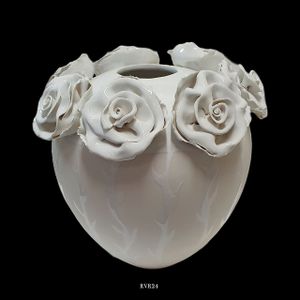
Elica Studio > Styling
Name: RVR24 – WHITE ROSE Material: Porcelain, glaze Finishing: Matte and glossy Sizes (cm): Approx. 31 (height) × 31 (width) × 29 (depth/diameter) Weight (g): ~900 Designed in: 2024 Collection: Naturalia Lead Time: 30 days Description: The RVR24 – WHITE ROSE vase, an exquisitely delicate and timelessly elegant piece from Elica Studio's renowned "Naturalia" collection, offers a pure artistic interpretation of the classic rose, integrated into a graceful sculptural form. Designed in 2024, this unique object transcends conventional decor, serving as a captivating sculptural element that brings a sense of refined artistry, pristine natural beauty, and subtle sophistication to any interior. It is an ideal choice for interior designers seeking to infuse spaces with understated luxury, a harmonious connection to nature, and an undeniable artistic presence. Masterfully crafted from fine porcelain, the RVR24 – WHITE ROSE vase is characterized by its pure white palette and the intricate interplay of its finishes. The piece features both matte and glossy applications of glaze, creating a subtle yet compelling textural dialogue across its surface. As vividly illustrated in the accompanying image, the vase features a graceful, rounded, and slightly tapering body, culminating in an elegant opening at the top. What truly defines this creation is the breathtaking three-dimensional sculpting of numerous white roses that encircle and adorn its entire upper rim, forming a lush, ethereal garland of blooms. Each rose is meticulously rendered with intricate details, from the delicate layering of petals to the subtle undulations that give them a lifelike quality. The pristine white of the porcelain highlights the sculptural precision and the inherent beauty of the floral form. The "Matte and glossy" finishing translates into a soft, velvety texture on the main body of the vase, allowing the sculpted roses to feature more luminous, glossy accents on their petals or within their folds, catching and reflecting light in a subtle dance. This refined interplay of textures enhances the depth and realism of the roses, making them appear almost freshly bloomed. The overall aesthetic is one of serene beauty, clean lines, and an enduring sense of classicism, reinterpreted for contemporary luxury spaces. The RVR24 – WHITE ROSE vase, with its blend of classical floral motifs, sophisticated finishes, and exquisite sculptural form, offers remarkable versatility for interior designers. It can serve as a stunning standalone art piece, commanding attention on a console table, a credenza, or a prominent pedestal. Its lightweight nature, at approximately 900 grams, combined with its graceful dimensions of approximately 31 cm in height and 29 cm in width at its widest point, makes it an adaptable addition to various luxury settings. While its design makes it primarily a decorative object, its profound artistic statement allows it to anchor a room or complement a curated collection of art. Its aesthetic is particularly well-suited for adding a touch of sophisticated naturalism to minimalist or Scandinavian-inspired interiors, enhancing a romantic or classic space, or serving as a serene focal point in a modern, elegant setting. Belonging to the "Naturalia" collection, it beautifully embodies the essence of nature, interpreted through a lens of refined artistry and timeless design. Designed in 2024, the RVR24 – WHITE ROSE vase showcases Elica Studio's continued innovation in ceramic art, ensuring its relevance in today's design landscape. For interior designers seeking to imbue their projects with unique character, a sense of refined artistry, and a touch of engaging conceptual depth, the RVR24 – WHITE ROSE vase is an unparalleled choice. Its distinctive aesthetic, thoughtful integration of form and finish, and captivating visual impact position it as an investment piece that will resonate with clients who appreciate bespoke quality, enduring design, and a connection to the artistic exploration of nature's profound and gentle beauty. With a standard lead time of 30 days, incorporating this exceptional sculpture into project timelines is straightforward, promising to deliver a compelling visual experience that enhances the overall ambiance of any sophisticated interior.
OCC 22 a
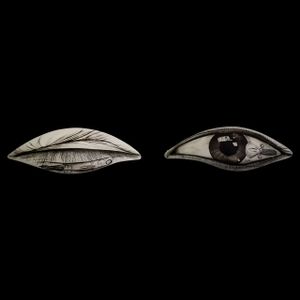
Elica Studio > Styling
OCC 22 a Material Porcelain, engobes, oxides, glaze Finishing Matte Sizes (cm) 38 X 15 X 4 Weight (g) 900 Designed in 2022 Collection Anatomika Lead Time: 30 days OCC22 A is a paired porcelain eye sculpture, where observation meets surreal narrative. Each eye is almond-shaped and sculpted from fine porcelain, with matte ivory glaze acting as a soft base for a highly detailed monochrome illustration. One eye is fully open, revealing a hyper-realistic iris and an illustrated surgical tool embedded in the lower lid. The second is closed—its lid feathered with fine ink-like linework and partially sealed by the same stylised tool motif. The use of cross-hatching and dense line drawing gives the eyes a poetic unease—one aware, the other sleeping, both marked by intrusion. The contrast between anatomical form and medical device hints at vulnerability, the line between seeing and being seen, or the discomfort of knowing. The asymmetry between the two eyes (one open, one shut) allows for more dynamic compositions and a deeper interpretive layer. Styling & Placement Suggestions Conceptual or Gallery Interiors: Display side-by-side on a neutral surface or wall-mounted as a symbolic diptych. Works well in narrative-driven spaces with high design awareness. Modern Minimalist Environments: Place above consoles or shelves as visual punctuation. Their quiet tone and detailed graphic quality suit monochrome interiors. Boutique & Artistic Studios: Ideal for creative offices, salons, or reception desks—especially where narrative, design, and symbolism matter. Reflective Spaces: OCC22 A can anchor areas designed for introspection, such as reading rooms, meditation nooks, or personal studios. Why Interior Designers Use OCC22 A Narrative Duality: Open and closed eyes create a sculptural dialogue of tension, presence, and privacy. Hand-Drawn Detail: Intricate black ink-like illustrations contrast softly with the ivory porcelain. Compact Impact: Modest in scale but emotionally dense—ideal for focal points in small vignettes. Metaphoric Versatility: Themes of surveillance, vulnerability, or poetic silence make this pair conceptually rich. Styling Tip: Use soft top lighting to enhance shadows within the linework and gently illuminate the curve of the form. Against a dark or textured background, the porcelain will pop subtly while the illustrations stay haunting and precise. OCC22 A is more than a visual accent—it is a sculptural metaphor. A gaze partially shielded, a lid half-closed, a tension unresolved. Perfect for interiors that thrive on narrative, silence, and deep visual thought.
TS 22 GOLDEN FACE
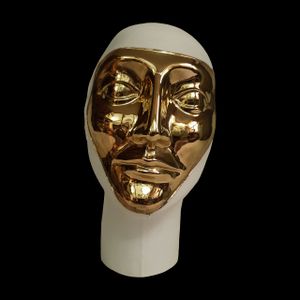
Elica Studio > Styling
TS 22 GOLDEN FACE Material Porcelain, engobes, oxides, glaze, 24 k gold Finishing Matte and glossy Sizes (cm) 20 X 25 Weight (g) 850 Designed in 2022 Collection Anatomika Lead Time: 30 days Description: The TS22 GOLDEN FACE from the Totemica Collection is a captivating piece of fine porcelain artistry, meticulously designed to infuse spaces with an aura of sophistication and enigmatic allure. This exquisite sculpture, featuring a matte white glazed base contrasting strikingly with a lustrous gold-plated face, stands at approximately 30 cm in height, with dimensions of 16 cm in width and 12 cm in depth, and weighing around 1100g. Created in 2022, it embodies a contemporary aesthetic that speaks to both classic elegance and modern design sensibilities, making it an indispensable asset for interior designers seeking to create truly unforgettable environments. For interior designers, the TS22 GOLDEN FACE offers unparalleled versatility and a profound narrative potential. Its dual-texture finishing – the serene matte white and the opulent gold – creates a dynamic visual tension that can anchor a room or serve as a focal point within a curated display. Imagine this piece gracing a minimalist console table in a high-end residential living room, where its golden face catches the ambient light, casting intriguing reflections and drawing the eye. In a luxury boutique hotel lobby, it could be positioned as a standalone art piece, inviting contemplation and adding a touch of avant-garde glamour. The deliberate choice of gold plating elevates the piece beyond mere decoration, transforming it into a statement of refined taste and a commitment to exceptional quality, attributes highly valued by discerning clientele. The artistic inspiration behind the Totemica Collection, and specifically the TS22 GOLDEN FACE, delves into the realm of ancient totems and the symbolic power of the human face. This allows designers to weave a rich story into their projects, connecting modern interiors with timeless themes of identity, mystery, and cultural heritage. It’s more than just an object; it’s a conversation starter, a piece that encourages viewers to pause and engage. For commercial spaces, this translates into memorable experiences for visitors, enhancing brand perception and fostering a sense of exclusivity. Consider its impact in a private club, a high-end retail environment, or even a contemporary art gallery, where its striking presence can complement existing art installations or stand proudly as a unique exhibit. Beyond its aesthetic appeal, the practical considerations for interior designers are well addressed. With a lead time of 30 days, project timelines can be managed efficiently, allowing for seamless integration into design plans. The robust fine porcelain material ensures durability and longevity, guaranteeing that this investment will continue to enhance spaces for years to come. Its approximate weight of 1100g provides stability, while its compact dimensions make it suitable for a variety of placements – from bookshelves and display niches to prominent pedestals. The intentional design ensures it can be viewed from multiple angles, offering a compelling visual experience regardless of its exact positioning. SEO optimization for this product emphasizes keywords crucial for interior design professionals. Terms such as "luxury porcelain sculpture," "gold accent decor," "contemporary art piece," "high-end interior design," "statement decor," and "abstract facial sculpture" would effectively capture the attention of designers searching for unique and impactful additions to their projects. The dual nature of its design – both classic in material (porcelain) and contemporary in execution (abstract form, gold plating) – appeals to a broad spectrum of design styles, from modern minimalist to eclectic maximalist. This versatility makes it an ideal choice for residential, commercial, and hospitality projects alike. In essence, the TS22 GOLDEN FACE is an embodiment of artistic expression and functional design. It's not merely a decorative item, but a strategic design element that can elevate the perceived value and aesthetic appeal of any interior. Its ability to create visual interest, spark conversation, and align with diverse design narratives positions it as an invaluable resource for interior designers committed to crafting distinctive, luxurious, and memorable spaces for their clients. Its elegance, symbolic depth, and meticulous craftsmanship make it a truly golden opportunity for design innovation.
BHR24 – ROCCO’S HEAD NAT
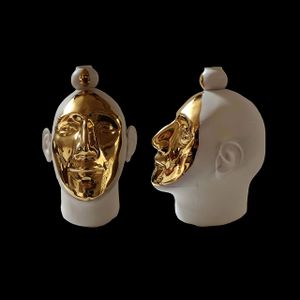
Elica Studio > Styling
BHR24 – ROCCO’S HEAD NAT Material Porcelain, glaze, 24 k gold Finishing Matte and glossy Sizes (cm) 30 X 28 X 38 Weight (g) 1500 Designed in 2024 Collection Anatomika Lead Time: 30 days Description: The BHR24 ROCCOS HEAD NAT, a compelling addition to the Anatomika Collection, represents the pinnacle of contemporary porcelain artistry, designed to infuse spaces with an unparalleled sense of luxury and intrigue. Crafted from exquisite fine porcelain, Designed in 2024, its striking aesthetic is defined by a serene matte white glazed head, dramatically contrasted by a meticulously gold-plated face that appears to emerge or recede from the porcelain form. A small, elegant spherical element atop the head, also finished in gold, completes this captivating composition. This piece is an indispensable asset for interior designers seeking to create environments that exude sophistication, artistic depth, and a touch of enigmatic allure. For interior designers, the BHR24 ROCCOS HEAD NAT offers immense versatility and a profound visual impact. The juxtaposition of the pure, minimalist matte white and the opulent, reflective gold creates a dynamic tension that commands attention. This piece can serve as a powerful focal point in a variety of high-end settings. Imagine it gracing a dark marble console table in a minimalist luxury residence, where the golden face reflects ambient light, creating a dazzling play of light and shadow. In a contemporary art gallery or a high-end commercial space, such as a boutique hotel lobby or a prestigious corporate office, it can embody refined taste and a commitment to exceptional design. The gold plating not only signifies luxury but also adds a warmth and glow that can beautifully complement a rich color palette or stand out against a more neutral backdrop. The artistic inspiration behind the Anatomika Collection, and specifically the ROCCOS HEAD NAT, explores themes of identity, transformation, and the multifaceted nature of the human psyche. The "natural" (NAT) aspect perhaps refers to the innate human form, dramatically elevated and adorned. This concept allows designers to weave a rich and philosophical narrative into their projects, connecting modern interiors with timeless humanistic explorations. It's more than just a decorative object; it’s a conversation starter, a piece that encourages viewers to ponder the layers of self and perception. For residential projects, this can create an atmosphere of intellectual sophistication and artistic appreciation. In commercial environments, it can contribute to a unique brand identity, fostering a sense of exclusivity and thoughtful curation. Practical considerations are well-addressed by the BHR24 ROCCOS HEAD NAT. Crafted from durable fine porcelain, it ensures longevity and maintains its exquisite appearance over time, making it a sustainable and enduring investment. The matte white glaze is elegant and easy to maintain, while the gold plating is expertly applied for lasting brilliance. A lead time of 30 days allows for efficient project planning and seamless integration into design schedules. Its stable weight and balanced dimensions make it suitable for a wide range of placements, from prominent display on a central pedestal to a subtle yet impactful accent within a curated display case. The multi-angle visual appeal, highlighted by the striking profile view, ensures its captivating presence from any vantage point. In terms of SEO, keywords crucial for interior designers searching for such pieces include "luxury gold face sculpture," "contemporary porcelain art," "matte white and gold decor," "abstract human head art," "high-end decorative object," "statement entryway decor," and "opulent sculpture for interiors." These terms accurately describe its aesthetic, conceptual depth, and suitability for various luxurious design applications, ensuring it is discoverable by professionals looking to infuse their projects with a blend of classical elegance and modern artistic expression. The timeless appeal of gold and white ensures its adaptability across diverse interior styles, from classic chic to ultra-modern. In conclusion, the BHR24 ROCCOS HEAD NAT from the Anatomika Collection is an exceptional piece that offers more than just decorative appeal. It is a powerful artistic statement and a versatile design element capable of transforming interiors into dynamic, sophisticated, and visually stunning environments. Its unique blend of minimalist form and opulent finishing, combined with its high-quality materials and thoughtful design, makes it an indispensable resource for interior designers committed to crafting truly distinctive and inspiring spaces for their discerning clientele.
Pisces – Vaso Pesci – VPB20
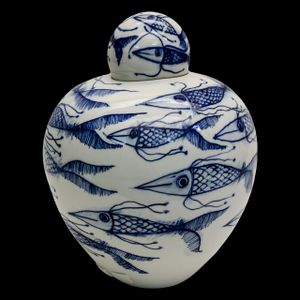
Elica Studio > Styling
Name: Pisces – Vaso Pesci – VPB20 Material: Fine porcelain Finishing: White glossy paint Sizes (cm): Approx. 35 × 35 × 35 (Height × Width × Diameter) Weight (g): ~1.5 Designed in: 2021 Collection: Naturalia Lead Time: 30 days Description: The Pisces – Vaso Pesci – VPB20, a beautifully crafted and artistically classic piece from Elica Studio's evocative "Naturalia" collection, offers a timeless interpretation of marine life with a charming, traditional aesthetic. Designed in 2021, this lidded vase transcends conventional decor, serving as a captivating sculptural element that brings a sense of refined artistry and serene elegance to any interior. It is an ideal choice for interior designers seeking to infuse spaces with a blend of classic charm, a touch of understated whimsy, and a harmonious connection to the aquatic world. Masterfully crafted from fine porcelain, the Pisces – Vaso Pesci – VPB20 is characterized by its crisp white base adorned with intricate blue illustrations. The entire piece is finished with a pristine white glossy paint, which enhances its elegant silhouette and provides a luminous surface that beautifully reflects light. As vividly illustrated in the accompanying image, the vase features a graceful, rounded, jar-like form, topped with a complementary spherical lid. Both the body of the vase and its lid are adorned with dynamic depictions of fish swimming gracefully in various directions. The illustrations are rendered in a delicate yet expressive blue, reminiscent of traditional delftware or classic blue-and-white porcelain. The fish are depicted with a lively sense of movement, their bodies textured with fine scales, and their fins drawn with elegant strokes that suggest propulsion through water. Surrounding the fish are subtle wavy lines and abstract strokes that further enhance the aquatic theme, creating a sense of an underwater ballet. The intricate detailing on both the fish and their environment speaks to a meticulous hand-painted quality, imbuing each piece with unique character. This artistic rendering, combined with the classic form, ensures the vase feels both timeless and exceptionally bespoke. The Pisces – Vaso Pesci – VPB20, with its unique blend of traditional artistry and fluid design, offers remarkable versatility for interior designers. It can serve as a stunning standalone art piece, commanding attention on a console table, a prominent shelf, or as a centerpiece on a dining table. Its lidded design allows for versatility, whether used to conceal small treasures or simply admired for its sculptural form. Its aesthetic is particularly well-suited for adding a touch of sophisticated classicism to modern interiors, or for enhancing a more traditionally inspired or coastal-themed space. Belonging to the "Naturalia" collection, it subtly connects to nature, celebrating marine life in a refined and artistic manner. With dimensions of approximately 35 cm in height, width, and depth, and weighing around 1.5 grams, the Pisces – Vaso Pesci – VPB20 is remarkably lightweight for its presence, making it easy to handle and place. Its unique form and serene aesthetic make it an ideal feature for a high-end residential living area, a boutique hotel lounge, or a sophisticated commercial space. Designed in 2021, this piece showcases a blend of classic influences and contemporary sensibilities, ensuring its relevance in today's design landscape. For interior designers seeking to imbue their projects with unique character, a sense of refined artistry, and a touch of engaging natural beauty, the Pisces – Vaso Pesci – VPB20 is an unparalleled choice. Its distinctive aesthetic, thoughtful integration of form and pattern, and captivating visual impact position it as an investment piece that will resonate with clients who appreciate bespoke quality, enduring design, and a connection to the artistic exploration of nature's timeless beauty. With a standard lead time of 30 days, incorporating this exceptional sculpture into project timelines is straightforward, promising to deliver a compelling visual experience that enhances the overall ambiance of any sophisticated interior.
Storie Cascina
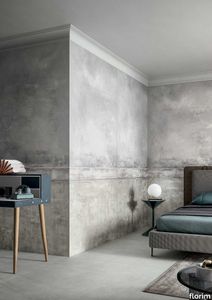
florim > Wall Paint
The faded wall fresco, damp stains in plaster. «Technological innovation enables us to reproduce on large-sized ceramic materials all the effects of wear and stratification that normally only time is able to create.» Giorgia Zanellato & Daniele Bortotto Children stare at the walls of a farmhouse, wondering what the cracks are, and whether every mark is a path and every path is a story. They think that miniature beings live in the air pockets that have formed, and the detaching plaster is like an avalanche cascading from a glacier. They don't ask why the colours are as they are, because they just had to be like that. And every square centimetre becomes the first page of an adventure that restarts at every break in the pattern. Could this be why we say that both textures and plots have twists, and stories are woven? As even children know, walls are tales. Not only do they contain adventures, emotions, moments, loves and hates and record them on their surfaces; their uneven, active surfaces generate new imaginary worlds, in which one can literally get lost. The "Storie" collection by Giorgia Zanellato and Daniele Bortotto brings this metaphor to three-dimensional life by expressing the moods, loves and hates and moments that the walls and floors of old Italian homes conserve, and capturing them in a frozen instant. The theme of time and the changes wrought in matter by the passing seasons, weather and human action have always been a strong source of inspiration for architects: some have tried to freeze it, while others have used sleight of hand to embrace it while resisting its effects, and yet others have accelerated, anticipated, directed and re-created it.<br /> Zanellato and Bortotto do all these things at once, engaging in a duel with History with a capital H, in which it is never clear who is winning: design or object, man or nature, culture or time. And it is probably this unresolved tension which makes the "Storie" designs so universal and meaningful, so intimate and yet familiar. The floor is the only thing we can be certain that everyone entering our home will touch, and at the same time it is the most intimate part, the most steeped in private happenings. They talk about having your "feet firmly on the ground". This image stands for common sense, but also a recognition of how things are, how things work. The wall is a synecdoche, too: it is the part of the home that expresses an idea of solidity, the layering of time, the passage of lives. "Storie" gives form to this metaphor by drawing a line that links the most classical of taste to a sophisticated modernity of taste and style. The two designers did a great deal of background work for this project: old Italian homes, country villas, noble palazzos, farmhouses and old factors, which become an unlimited source of motifs, colours, textures and materials. But, perhaps unconsciously, literature also re-emerges from this survey of locations, with its blend of aestheticism and decadence, with echoes of Wilde and D'Annunzio, Ruskin and Huysmans. "Storie" would be the ideal backdrop for Des Esseintes, the dandy in "A Rebours". And in fact the collection clearly has strong theatrical connections, arising partly from its storytelling connotations but also from its scene-setting potential.<br /> It represents life, which we are, have been and wish to continue to be. And it is thrilling to realise that this vision comes from the youngest designers in CEDIT's new era, who have successfully taken a confident, cultured, astute, sidelong approach to the most ancient of topics, with a persuasive effect which appears, at least, to be not at all intimidated by the many stories, the type of product they are dealing with, the catalogue in which they are included, the designers who have gone before them or, naturally, the adventures that lie concealed in the historic dwellings they reproduce. The reference to Italy, on the other hand, is in perfect harmony with the work of the brand and its past and present designers: it is intrinsic to the perfection of the production process that underlies the collection, the relationship with the brand's tradition and its local roots, and the intelligent, strategic use of its innovations in the treatment of this complex material.Child's play? Yes, but with the integrity and ability to enchant unique to specific designs, capable of an immediacy of vision and feeling that makes them little novels written in cement.
Storie Palazzo

florim > Wall Paint
The faded wall fresco, damp stains in plaster. «Technological innovation enables us to reproduce on large-sized ceramic materials all the effects of wear and stratification that normally only time is able to create.» Giorgia Zanellato & Daniele Bortotto Children stare at the walls of a farmhouse, wondering what the cracks are, and whether every mark is a path and every path is a story. They think that miniature beings live in the air pockets that have formed, and the detaching plaster is like an avalanche cascading from a glacier. They don't ask why the colours are as they are, because they just had to be like that. And every square centimetre becomes the first page of an adventure that restarts at every break in the pattern. Could this be why we say that both textures and plots have twists, and stories are woven? As even children know, walls are tales. Not only do they contain adventures, emotions, moments, loves and hates and record them on their surfaces; their uneven, active surfaces generate new imaginary worlds, in which one can literally get lost. The "Storie" collection by Giorgia Zanellato and Daniele Bortotto brings this metaphor to three-dimensional life by expressing the moods, loves and hates and moments that the walls and floors of old Italian homes conserve, and capturing them in a frozen instant. The theme of time and the changes wrought in matter by the passing seasons, weather and human action have always been a strong source of inspiration for architects: some have tried to freeze it, while others have used sleight of hand to embrace it while resisting its effects, and yet others have accelerated, anticipated, directed and re-created it.<br /> Zanellato and Bortotto do all these things at once, engaging in a duel with History with a capital H, in which it is never clear who is winning: design or object, man or nature, culture or time. And it is probably this unresolved tension which makes the "Storie" designs so universal and meaningful, so intimate and yet familiar. The floor is the only thing we can be certain that everyone entering our home will touch, and at the same time it is the most intimate part, the most steeped in private happenings. They talk about having your "feet firmly on the ground". This image stands for common sense, but also a recognition of how things are, how things work. The wall is a synecdoche, too: it is the part of the home that expresses an idea of solidity, the layering of time, the passage of lives. "Storie" gives form to this metaphor by drawing a line that links the most classical of taste to a sophisticated modernity of taste and style. The two designers did a great deal of background work for this project: old Italian homes, country villas, noble palazzos, farmhouses and old factors, which become an unlimited source of motifs, colours, textures and materials. But, perhaps unconsciously, literature also re-emerges from this survey of locations, with its blend of aestheticism and decadence, with echoes of Wilde and D'Annunzio, Ruskin and Huysmans. "Storie" would be the ideal backdrop for Des Esseintes, the dandy in "A Rebours". And in fact the collection clearly has strong theatrical connections, arising partly from its storytelling connotations but also from its scene-setting potential.<br /> It represents life, which we are, have been and wish to continue to be. And it is thrilling to realise that this vision comes from the youngest designers in CEDIT's new era, who have successfully taken a confident, cultured, astute, sidelong approach to the most ancient of topics, with a persuasive effect which appears, at least, to be not at all intimidated by the many stories, the type of product they are dealing with, the catalogue in which they are included, the designers who have gone before them or, naturally, the adventures that lie concealed in the historic dwellings they reproduce. The reference to Italy, on the other hand, is in perfect harmony with the work of the brand and its past and present designers: it is intrinsic to the perfection of the production process that underlies the collection, the relationship with the brand's tradition and its local roots, and the intelligent, strategic use of its innovations in the treatment of this complex material.Child's play? Yes, but with the integrity and ability to enchant unique to specific designs, capable of an immediacy of vision and feeling that makes them little novels written in cement.
Storie Masseria

florim > Wall Paint
The faded wall fresco, damp stains in plaster. «Technological innovation enables us to reproduce on large-sized ceramic materials all the effects of wear and stratification that normally only time is able to create.» Giorgia Zanellato & Daniele Bortotto Children stare at the walls of a farmhouse, wondering what the cracks are, and whether every mark is a path and every path is a story. They think that miniature beings live in the air pockets that have formed, and the detaching plaster is like an avalanche cascading from a glacier. They don't ask why the colours are as they are, because they just had to be like that. And every square centimetre becomes the first page of an adventure that restarts at every break in the pattern. Could this be why we say that both textures and plots have twists, and stories are woven? As even children know, walls are tales. Not only do they contain adventures, emotions, moments, loves and hates and record them on their surfaces; their uneven, active surfaces generate new imaginary worlds, in which one can literally get lost. The "Storie" collection by Giorgia Zanellato and Daniele Bortotto brings this metaphor to three-dimensional life by expressing the moods, loves and hates and moments that the walls and floors of old Italian homes conserve, and capturing them in a frozen instant. The theme of time and the changes wrought in matter by the passing seasons, weather and human action have always been a strong source of inspiration for architects: some have tried to freeze it, while others have used sleight of hand to embrace it while resisting its effects, and yet others have accelerated, anticipated, directed and re-created it.<br /> Zanellato and Bortotto do all these things at once, engaging in a duel with History with a capital H, in which it is never clear who is winning: design or object, man or nature, culture or time. And it is probably this unresolved tension which makes the "Storie" designs so universal and meaningful, so intimate and yet familiar. The floor is the only thing we can be certain that everyone entering our home will touch, and at the same time it is the most intimate part, the most steeped in private happenings. They talk about having your "feet firmly on the ground". This image stands for common sense, but also a recognition of how things are, how things work. The wall is a synecdoche, too: it is the part of the home that expresses an idea of solidity, the layering of time, the passage of lives. "Storie" gives form to this metaphor by drawing a line that links the most classical of taste to a sophisticated modernity of taste and style. The two designers did a great deal of background work for this project: old Italian homes, country villas, noble palazzos, farmhouses and old factors, which become an unlimited source of motifs, colours, textures and materials. But, perhaps unconsciously, literature also re-emerges from this survey of locations, with its blend of aestheticism and decadence, with echoes of Wilde and D'Annunzio, Ruskin and Huysmans. "Storie" would be the ideal backdrop for Des Esseintes, the dandy in "A Rebours". And in fact the collection clearly has strong theatrical connections, arising partly from its storytelling connotations but also from its scene-setting potential.<br /> It represents life, which we are, have been and wish to continue to be. And it is thrilling to realise that this vision comes from the youngest designers in CEDIT's new era, who have successfully taken a confident, cultured, astute, sidelong approach to the most ancient of topics, with a persuasive effect which appears, at least, to be not at all intimidated by the many stories, the type of product they are dealing with, the catalogue in which they are included, the designers who have gone before them or, naturally, the adventures that lie concealed in the historic dwellings they reproduce. The reference to Italy, on the other hand, is in perfect harmony with the work of the brand and its past and present designers: it is intrinsic to the perfection of the production process that underlies the collection, the relationship with the brand's tradition and its local roots, and the intelligent, strategic use of its innovations in the treatment of this complex material.Child's play? Yes, but with the integrity and ability to enchant unique to specific designs, capable of an immediacy of vision and feeling that makes them little novels written in cement.
Storie Villa

florim > Wall Paint
The faded wall fresco, damp stains in plaster. «Technological innovation enables us to reproduce on large-sized ceramic materials all the effects of wear and stratification that normally only time is able to create.» Giorgia Zanellato & Daniele Bortotto Children stare at the walls of a farmhouse, wondering what the cracks are, and whether every mark is a path and every path is a story. They think that miniature beings live in the air pockets that have formed, and the detaching plaster is like an avalanche cascading from a glacier. They don't ask why the colours are as they are, because they just had to be like that. And every square centimetre becomes the first page of an adventure that restarts at every break in the pattern. Could this be why we say that both textures and plots have twists, and stories are woven? As even children know, walls are tales. Not only do they contain adventures, emotions, moments, loves and hates and record them on their surfaces; their uneven, active surfaces generate new imaginary worlds, in which one can literally get lost. The "Storie" collection by Giorgia Zanellato and Daniele Bortotto brings this metaphor to three-dimensional life by expressing the moods, loves and hates and moments that the walls and floors of old Italian homes conserve, and capturing them in a frozen instant. The theme of time and the changes wrought in matter by the passing seasons, weather and human action have always been a strong source of inspiration for architects: some have tried to freeze it, while others have used sleight of hand to embrace it while resisting its effects, and yet others have accelerated, anticipated, directed and re-created it.<br /> Zanellato and Bortotto do all these things at once, engaging in a duel with History with a capital H, in which it is never clear who is winning: design or object, man or nature, culture or time. And it is probably this unresolved tension which makes the "Storie" designs so universal and meaningful, so intimate and yet familiar. The floor is the only thing we can be certain that everyone entering our home will touch, and at the same time it is the most intimate part, the most steeped in private happenings. They talk about having your "feet firmly on the ground". This image stands for common sense, but also a recognition of how things are, how things work. The wall is a synecdoche, too: it is the part of the home that expresses an idea of solidity, the layering of time, the passage of lives. "Storie" gives form to this metaphor by drawing a line that links the most classical of taste to a sophisticated modernity of taste and style. The two designers did a great deal of background work for this project: old Italian homes, country villas, noble palazzos, farmhouses and old factors, which become an unlimited source of motifs, colours, textures and materials. But, perhaps unconsciously, literature also re-emerges from this survey of locations, with its blend of aestheticism and decadence, with echoes of Wilde and D'Annunzio, Ruskin and Huysmans. "Storie" would be the ideal backdrop for Des Esseintes, the dandy in "A Rebours". And in fact the collection clearly has strong theatrical connections, arising partly from its storytelling connotations but also from its scene-setting potential.<br /> It represents life, which we are, have been and wish to continue to be. And it is thrilling to realise that this vision comes from the youngest designers in CEDIT's new era, who have successfully taken a confident, cultured, astute, sidelong approach to the most ancient of topics, with a persuasive effect which appears, at least, to be not at all intimidated by the many stories, the type of product they are dealing with, the catalogue in which they are included, the designers who have gone before them or, naturally, the adventures that lie concealed in the historic dwellings they reproduce. The reference to Italy, on the other hand, is in perfect harmony with the work of the brand and its past and present designers: it is intrinsic to the perfection of the production process that underlies the collection, the relationship with the brand's tradition and its local roots, and the intelligent, strategic use of its innovations in the treatment of this complex material.Child's play? Yes, but with the integrity and ability to enchant unique to specific designs, capable of an immediacy of vision and feeling that makes them little novels written in cement.
Storie Castello

florim > Wall Paint
The faded wall fresco, damp stains in plaster. «Technological innovation enables us to reproduce on large-sized ceramic materials all the effects of wear and stratification that normally only time is able to create.» Giorgia Zanellato & Daniele Bortotto Children stare at the walls of a farmhouse, wondering what the cracks are, and whether every mark is a path and every path is a story. They think that miniature beings live in the air pockets that have formed, and the detaching plaster is like an avalanche cascading from a glacier. They don't ask why the colours are as they are, because they just had to be like that. And every square centimetre becomes the first page of an adventure that restarts at every break in the pattern. Could this be why we say that both textures and plots have twists, and stories are woven? As even children know, walls are tales. Not only do they contain adventures, emotions, moments, loves and hates and record them on their surfaces; their uneven, active surfaces generate new imaginary worlds, in which one can literally get lost. The "Storie" collection by Giorgia Zanellato and Daniele Bortotto brings this metaphor to three-dimensional life by expressing the moods, loves and hates and moments that the walls and floors of old Italian homes conserve, and capturing them in a frozen instant. The theme of time and the changes wrought in matter by the passing seasons, weather and human action have always been a strong source of inspiration for architects: some have tried to freeze it, while others have used sleight of hand to embrace it while resisting its effects, and yet others have accelerated, anticipated, directed and re-created it.<br /> Zanellato and Bortotto do all these things at once, engaging in a duel with History with a capital H, in which it is never clear who is winning: design or object, man or nature, culture or time. And it is probably this unresolved tension which makes the "Storie" designs so universal and meaningful, so intimate and yet familiar. The floor is the only thing we can be certain that everyone entering our home will touch, and at the same time it is the most intimate part, the most steeped in private happenings. They talk about having your "feet firmly on the ground". This image stands for common sense, but also a recognition of how things are, how things work. The wall is a synecdoche, too: it is the part of the home that expresses an idea of solidity, the layering of time, the passage of lives. "Storie" gives form to this metaphor by drawing a line that links the most classical of taste to a sophisticated modernity of taste and style. The two designers did a great deal of background work for this project: old Italian homes, country villas, noble palazzos, farmhouses and old factors, which become an unlimited source of motifs, colours, textures and materials. But, perhaps unconsciously, literature also re-emerges from this survey of locations, with its blend of aestheticism and decadence, with echoes of Wilde and D'Annunzio, Ruskin and Huysmans. "Storie" would be the ideal backdrop for Des Esseintes, the dandy in "A Rebours". And in fact the collection clearly has strong theatrical connections, arising partly from its storytelling connotations but also from its scene-setting potential.<br /> It represents life, which we are, have been and wish to continue to be. And it is thrilling to realise that this vision comes from the youngest designers in CEDIT's new era, who have successfully taken a confident, cultured, astute, sidelong approach to the most ancient of topics, with a persuasive effect which appears, at least, to be not at all intimidated by the many stories, the type of product they are dealing with, the catalogue in which they are included, the designers who have gone before them or, naturally, the adventures that lie concealed in the historic dwellings they reproduce. The reference to Italy, on the other hand, is in perfect harmony with the work of the brand and its past and present designers: it is intrinsic to the perfection of the production process that underlies the collection, the relationship with the brand's tradition and its local roots, and the intelligent, strategic use of its innovations in the treatment of this complex material.Child's play? Yes, but with the integrity and ability to enchant unique to specific designs, capable of an immediacy of vision and feeling that makes them little novels written in cement.
Storie Casale

florim > Wall Paint
The faded wall fresco, damp stains in plaster. «Technological innovation enables us to reproduce on large-sized ceramic materials all the effects of wear and stratification that normally only time is able to create.» Giorgia Zanellato & Daniele Bortotto Children stare at the walls of a farmhouse, wondering what the cracks are, and whether every mark is a path and every path is a story. They think that miniature beings live in the air pockets that have formed, and the detaching plaster is like an avalanche cascading from a glacier. They don't ask why the colours are as they are, because they just had to be like that. And every square centimetre becomes the first page of an adventure that restarts at every break in the pattern. Could this be why we say that both textures and plots have twists, and stories are woven? As even children know, walls are tales. Not only do they contain adventures, emotions, moments, loves and hates and record them on their surfaces; their uneven, active surfaces generate new imaginary worlds, in which one can literally get lost. The "Storie" collection by Giorgia Zanellato and Daniele Bortotto brings this metaphor to three-dimensional life by expressing the moods, loves and hates and moments that the walls and floors of old Italian homes conserve, and capturing them in a frozen instant. The theme of time and the changes wrought in matter by the passing seasons, weather and human action have always been a strong source of inspiration for architects: some have tried to freeze it, while others have used sleight of hand to embrace it while resisting its effects, and yet others have accelerated, anticipated, directed and re-created it.<br /> Zanellato and Bortotto do all these things at once, engaging in a duel with History with a capital H, in which it is never clear who is winning: design or object, man or nature, culture or time. And it is probably this unresolved tension which makes the "Storie" designs so universal and meaningful, so intimate and yet familiar. The floor is the only thing we can be certain that everyone entering our home will touch, and at the same time it is the most intimate part, the most steeped in private happenings. They talk about having your "feet firmly on the ground". This image stands for common sense, but also a recognition of how things are, how things work. The wall is a synecdoche, too: it is the part of the home that expresses an idea of solidity, the layering of time, the passage of lives. "Storie" gives form to this metaphor by drawing a line that links the most classical of taste to a sophisticated modernity of taste and style. The two designers did a great deal of background work for this project: old Italian homes, country villas, noble palazzos, farmhouses and old factors, which become an unlimited source of motifs, colours, textures and materials. But, perhaps unconsciously, literature also re-emerges from this survey of locations, with its blend of aestheticism and decadence, with echoes of Wilde and D'Annunzio, Ruskin and Huysmans. "Storie" would be the ideal backdrop for Des Esseintes, the dandy in "A Rebours". And in fact the collection clearly has strong theatrical connections, arising partly from its storytelling connotations but also from its scene-setting potential.<br /> It represents life, which we are, have been and wish to continue to be. And it is thrilling to realise that this vision comes from the youngest designers in CEDIT's new era, who have successfully taken a confident, cultured, astute, sidelong approach to the most ancient of topics, with a persuasive effect which appears, at least, to be not at all intimidated by the many stories, the type of product they are dealing with, the catalogue in which they are included, the designers who have gone before them or, naturally, the adventures that lie concealed in the historic dwellings they reproduce. The reference to Italy, on the other hand, is in perfect harmony with the work of the brand and its past and present designers: it is intrinsic to the perfection of the production process that underlies the collection, the relationship with the brand's tradition and its local roots, and the intelligent, strategic use of its innovations in the treatment of this complex material.Child's play? Yes, but with the integrity and ability to enchant unique to specific designs, capable of an immediacy of vision and feeling that makes them little novels written in cement.
BHR25 FLOWERS
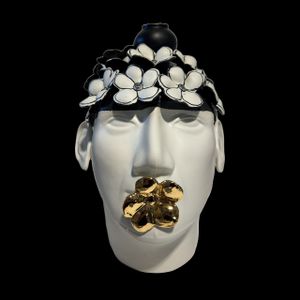
Elica Studio > Styling
BHR25 FLOWERS Material Porcelain, engobes, oxides, glaze, 24k gold Finishing Matte and glossy Sizes (cm) 30 X 25 X 39 Weight (g) 1600 Designed in 2025 Collection Anatomika Lead Time: 30 days Description: The BHR25 FLOWERS, a captivating and intricate piece from the Anatomika Collection, is a breathtaking example of contemporary porcelain artistry, designed to bring a profound sense of beauty, contrast, and artistic flourish to any interior. Designed in 2025, its aesthetic is a rich tapestry of finishes: a serene matte white glazed face, a striking black glazed cap adorned with delicate black ink-style illustrations, a cluster of meticulously hand-sculpted white porcelain flowers with black accents crowning the head, and a bold, gold-plated interpretation of lips. This piece offers interior designers an unparalleled opportunity to introduce a sophisticated blend of contrasting textures, opulent details, and whimsical artistry into their projects. For interior designers, the BHR25 FLOWERS is an exceptionally versatile and impactful design element that speaks volumes about curated taste and artistic bravery. The striking juxtaposition of the pure white face, the deep black cap, the intricate white flowers, and the lustrous gold lips creates a dynamic visual narrative. This sculpture is ideally suited for spaces that aim to evoke a sense of modern romanticism, sophisticated eclecticism, or even surrealistic charm. Imagine it as a central focal point on a sleek vanity in a luxurious dressing room, or commanding attention on a minimalist pedestal in a high-end fashion boutique. In a contemporary residential living room, it can serve as a conversation starter, inviting guests to explore its diverse textures and symbolic elements. The hand-sculpted flowers add an organic, delicate dimension, contrasting beautifully with the more rigid structure of the head, while the gold lips provide a luxurious and sensual touch. The artistic inspiration behind the Anatomika Collection, and particularly the FLOWERS design, delves into themes of beauty, expression, and the interplay between natural forms and human artistry. The flowers can symbolize growth, renewal, or perhaps a crown of thought and creativity, while the gold lips hint at speech, silence, or the unspoken desires that drive human nature. This rich thematic tapestry provides interior designers with a compelling story to integrate into their projects, allowing them to craft environments that are not only visually stunning but also emotionally resonant and intellectually stimulating. For residential projects, this sculpture can foster an atmosphere of refined elegance and artistic curiosity. In commercial environments, such as upscale salons, art galleries, or luxury event spaces, it can contribute to a unique brand identity, attracting clientele who appreciate bespoke craftsmanship and a daring aesthetic. Practical considerations are well-addressed by the BHR25 FLOWERS. Crafted from durable fine porcelain, it ensures longevity and maintains its exquisite appearance over time, making it a sustainable and enduring investment. The matte white and black glazes are elegant and easy to maintain. The hand-sculpted porcelain flowers are meticulously formed and securely attached, ensuring their delicate beauty endures, and the gold plating on the lips is expertly applied for lasting brilliance. A lead time of 30 days allows for efficient project planning and seamless integration into design schedules. Its stable weight and balanced dimensions make it suitable for a wide range of placements, from prominent display on a central table to a subtle yet impactful accent within a curated display case. The multi-textured and multi-finished surface invites tactile exploration, enhancing the overall sensory experience. In conclusion, the BHR25 FLOWERS from the Anatomika Collection is far more than a decorative item; it is a profound artistic statement and a versatile design tool capable of transforming interiors into dynamic, sophisticated, and emotionally resonant environments. Its unique blend of delicate beauty and bold contrast, combined with high-quality materials and thoughtful design, makes it an indispensable resource for interior designers committed to crafting truly distinctive and inspiring spaces for their discerning clientele.
VAS 22 BLUE
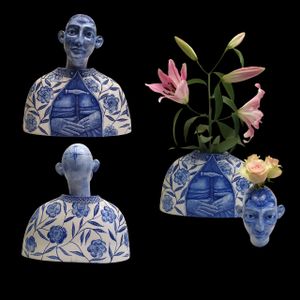
Elica Studio > Styling
VAS 22 BLUE Material Porcelain, engobes, oxides, glaze Finishing Glossy Sizes (cm) 44 X 19 X 53 Weight (g) 2600 Designed in 2022 Collection Anatomika Lead Time: 30 days Description: The VAS22 BLUE, a distinctive and highly versatile piece from the Totemica Collection, is an exquisite work of fine porcelain artistry designed to infuse spaces with a blend of classical charm and contemporary artistic expression. This captivating sculpture was designed in 2022. Its serene white glazed surface serves as the canvas for a captivating hand-painted blue ink-style illustration, particularly focused around the crown and features, hinting at a classical bust with a modern, artistic reinterpretation. The integrated opening at the top allows it to function as a unique and striking vase, making it an invaluable asset for interior designers seeking to combine sculptural beauty with practical elegance. For interior designers, the VAS22 BLUE offers unparalleled versatility and aesthetic appeal. The timeless combination of blue and white, reminiscent of traditional Delftware or Chinoiserie, is rendered with a contemporary artistic hand, allowing it to seamlessly integrate into a wide array of design schemes. In a coastal-inspired interior, it can introduce a fresh, artisanal touch. In a minimalist setting, it provides a pop of color and intricate detail without overwhelming the clean lines. For a more eclectic or transitional space, its blend of classical form and modern painting can bridge different design eras. The key feature of this piece is its dual functionality as both a sculpture and a vase. This allows designers to dynamically alter the aesthetic of a space by simply adding fresh flowers, transforming the piece from a static art object into a living, evolving display, adding softness, color, and natural texture. The artistic inspiration behind the Totemica Collection, and specifically the VAS22 BLUE, often draws from the human form as a vessel for artistic expression, with the blue ink illustrations potentially evoking studies of anatomy, philosophical thought, or even patterns inspired by nature or ancient symbolism. This intellectual and artistic depth provides interior designers with a compelling narrative to integrate into their projects, allowing them to craft spaces that are not only visually pleasing but also thought-provoking. For residential projects, this piece can elevate a living room, dining area, or bedroom, fostering an atmosphere of cultured elegance and artistic appreciation. In commercial settings, such as high-end florists, boutique hotels, or sophisticated cafes, the VAS22 BLUE can serve as a unique centerpiece or a memorable accent that reinforces a brand's commitment to quality, artistry, and distinctive design. Practical considerations are well-addressed by the VAS22 BLUE. Crafted from durable fine porcelain, it ensures longevity and maintains its pristine appearance over time, making it a sustainable and enduring investment. The hand-painted blue ink-style illustration is permanently fixed, ensuring its vibrant details endure, and the white glaze is easy to maintain. A lead time of 30 days allows for efficient project planning and seamless integration into design schedules. Its stable weight and balanced dimensions make it suitable for various placements, from prominent display on a central table to a subtle yet impactful accent within a curated display case. The ability to use it as a vase adds significant functional value, enhancing its appeal for designers. In conclusion, the VAS22 BLUE from the Totemica Collection is far more than a decorative item; it is a profound artistic statement and a highly versatile design tool capable of transforming interiors into dynamic, sophisticated, and aesthetically rich environments. Its unique blend of artistic beauty, functional elegance, and high-quality craftsmanship makes it an indispensable resource for interior designers committed to crafting truly distinctive and inspiring spaces for their discerning clientele.
BEGONIAS
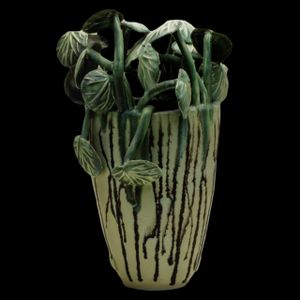
Elica Studio > Styling
Name: EGONIAS Material: Stoneware, engobes, oxides, glaze Finishing: Matte Sizes (cm): Approx. 26 (diameter/width) × 40 (height) Weight (g): ~4000 Designed in: 2012 Collection: Naturalia Lead Time: 30 days Description: The EGONIAS, a captivating and richly textured sculpture from Elica Studio's celebrated "Naturalia" collection, offers a unique blend of organic inspiration and refined artistry, meticulously designed to enrich sophisticated interior spaces. Created in 2012, this piece is more than a decorative item; it is a testament to the enduring beauty of botanical forms, reinterpreted through a contemporary lens, making it an exceptional addition for interior designers seeking to infuse projects with natural elegance and artistic depth. Crafted from robust stoneware, the EGONIAS boasts a distinctive dual aesthetic, seamlessly merging a structured base with a profusion of organic forms. The main body of the sculpture, as seen in previous similar designs, is likely characterized by a clean, elegant silhouette, potentially adorned with subtle textures or patterns that enhance its foundational appeal. The entire piece is treated with a matte finish, achieved through the expert application of engobes, oxides, and glaze. This refined surface treatment absorbs light beautifully, highlighting the intricate details and tactile qualities of the stoneware, creating a warm, inviting presence. The defining feature of the EGONIAS, consistent with its botanical name, lies in its meticulously sculpted elements that evoke lush, cascading foliage, reminiscent of begonia leaves. These organic forms are rendered with exquisite detail, showcasing lifelike veins and naturalistic contours, giving them an almost living quality. The use of oxides within the material likely contributes to varied green or earthy tones in these leafy elements, enhancing their naturalistic appeal and creating a beautiful contrast with the vase's base. This harmonious interplay between the structured vessel and the fluid, abundant foliage creates a dynamic composition that is both visually striking and profoundly serene. The versatility of the EGONIAS is a significant asset for interior designers. It introduces a vibrant touch of nature and sculptural form into any setting, whether it's a minimalist space needing an organic focal point or a richly layered interior seeking an artisanal accent. Its connection to the "Naturalia" collection emphasizes its inspiration from the natural world, allowing it to seamlessly integrate into biophilic design themes, bringing the tranquility and beauty of the outdoors inside. With dimensions of approximately 26 cm in width (or diameter) and a notable 40 cm in height, and weighing a substantial 4000 grams, the EGONIAS possesses a commanding yet balanced presence. Its robust nature and versatile size make it an ideal centerpiece for a dining table, a distinctive accent on a large console in an entryway, or a curated addition to a sophisticated lounge area or high-end commercial space. The deliberate design, rooted in 2012, ensures its timeless appeal, affirming its sustained relevance in contemporary interiors. For interior designers seeking to imbue their projects with unique character, a sense of lush vitality, and a profound artistic sensibility, the EGONIAS is an unparalleled choice. Its intricate details, substantial form, and refined finish position it as an investment piece that will resonate with clients who appreciate bespoke quality, enduring design, and a connection to the artistry of nature. With a standard lead time of 30 days, incorporating this exceptional sculpture into project timelines is straightforward, promising to deliver a profound visual and textural experience that enhances the overall ambiance of any sophisticated interior.
NINPHAEAE (wall elements) NFB10 –NFG10 – NFM10 – NFP10
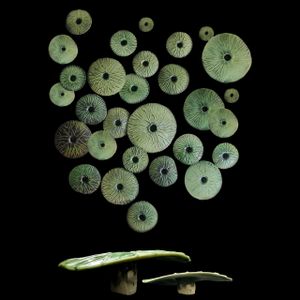
Elica Studio > Styling
Name: INPHAEAE (wall elements) NFB10 – NFG10 – NFM10 – NFP10 Material: Stoneware, engobes, oxides, glaze Finishing: Matte Sizes (cm): Approx. 39, 30, 25 (diameter/width) Weight (g): ~2200 (per piece) Designed in: 2010 Collection: Naturalia Lead Time: 30 days Description: The INPHAEAE wall elements, a compelling and innovative collection from Elica Studio's "Naturalia" series, offer interior designers an exceptional opportunity to create dynamic, textural, and artistically rich wall installations. Designed in 2010, these modular pieces are more than mere decor; they are sculptural components that invite bespoke arrangements, transforming flat surfaces into vibrant, three-dimensional canvases. Rooted in the subtle intricacies of the natural world, the INPHAEAE elements provide a sophisticated touch of organic modernism. Crafted from robust stoneware, each INPHAEAE element is meticulously finished with engobes, oxides, and glaze, resulting in a rich, matte surface. This refined treatment absorbs light beautifully, highlighting the intricate textures and earthy tones without harsh reflections. As vividly illustrated in the accompanying image, these elements are circular, disc-like forms, presented in varying sizes (approximately 39 cm, 30 cm, and 25 cm in diameter). Their surfaces are characterized by a captivating array of organic textures, including radiating lines, subtle undulations, and a prominent central depression or aperture. This detailing evokes the delicate structures of microscopic marine life, fossilized imprints, or the complex patterns found within seeds and spores, linking directly to the "Naturalia" collection's ethos. The range (NFB10 – NFG10 – NFM10 – NFP10) indicates a selection of potential finishes, with the depicted elements showcasing a spectrum of sophisticated greens. These verdant hues, achieved through carefully balanced oxides, range from muted sage to deeper forest tones, mimicking the natural variation found in botanical and aquatic environments. This palette allows for the creation of cohesive yet visually diverse arrangements, enabling designers to evoke a sense of organic growth and natural movement across a wall. The matte finish enhances the raw, tactile quality of the stoneware, inviting touch and adding a grounding presence to any interior scheme. Weighing approximately 2200 grams per piece, these wall elements possess a substantial yet manageable weight, ensuring stability when installed while facilitating flexible arrangements. Their modular nature is a significant advantage for interior designers, allowing for custom compositions that can be scaled to fit any space, from an intimate accent wall in a luxury residence to a grand installation in a high-end commercial lobby or hospitality venue. They can be arranged in dense clusters for a dramatic effect, or sparsely placed to create a subtle rhythm, bringing a bespoke, art-gallery feel to the environment. Designed in 2010, the INPHAEAE wall elements demonstrate a timeless aesthetic that remains highly relevant in contemporary design. They are particularly well-suited for projects where designers seek to integrate biophilic elements, create unique textural narratives, and introduce a sense of serene, understated luxury. Their blend of organic form, subtle color variation, and tactile appeal positions them as an investment in enduring artistry. With a standard lead time of 30 days, incorporating these exceptional wall elements into project timelines is straightforward, promising to deliver a profound visual and textural experience that transforms ordinary walls into captivating artistic statements, leaving a lasting impression of refined taste and natural sophistication.
ROSAM
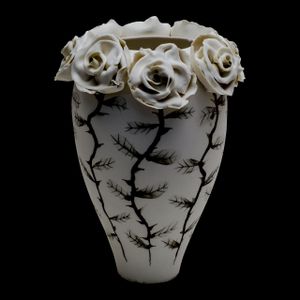
Elica Studio > Styling
Name: ROSAM Material: Porcelain, glaze, oxides Finishing: Matte Sizes (cm): Approx. 25 (height) × 34 (diameter/width at widest point) Weight (g): ~2500 Designed in: 2000 Collection: Naturalia Lead Time: 30 days Description: The ROSAM vase, an exquisitely crafted and poetically evocative piece from Elica Studio's celebrated "Naturalia" collection, offers a profound artistic interpretation of the timeless rose, masterfully integrated into a functional yet sculptural form. Designed in 2000, this unique object transcends conventional decor, serving as a powerful sculptural element that brings a sense of refined artistry, natural elegance, and subtle drama to any interior. It is an ideal choice for interior designers seeking to infuse spaces with a blend of classic floral charm, contemporary conceptual depth, and an undeniable artistic presence. Masterfully crafted from fine porcelain, the ROSAM vase is characterized by its rich textural contrasts and monochromatic palette. The entire piece is finished with a sophisticated matte coating, achieved through the expert application of glazes and oxides, which lends it an understated elegance and a soft, tactile appeal. As vividly illustrated in the accompanying image, the vase features a graceful, tapering cylindrical form, subtly flaring towards the top. What truly defines this creation is the breathtaking three-dimensional sculpting of numerous white roses that encircle and crown its entire rim, forming a lush, continuous garland of blooms. Each rose is meticulously rendered with intricate details, from the delicate layering of petals to the subtle undulations that give them a lifelike quality. These sculpted white roses stand in striking contrast to the body of the vase, which is adorned with bold, hand-drawn or applied patterns of dark, thorny vines. These black thorny motifs crawl up from the base of the vase, reaching towards the pristine white roses, creating a powerful visual tension between beauty and danger, fragility and resilience. This deliberate juxtaposition of the delicate, soft roses and the stark, sharp thorns speaks to the complex nature of beauty itself, making the piece not just decorative but deeply symbolic. The monochromatic scheme further accentuates the forms and textures, allowing the artistic narrative to take center stage. The ROSAM vase, with its unique blend of classical floral motifs, symbolic contrasts, and exquisite sculptural form, offers remarkable versatility for interior designers. It can serve as a stunning standalone art piece, commanding attention on a console table, a credenza, or a prominent pedestal. While capable of holding flora, its inherent artistic merit allows it to function purely as a sculptural object, an art piece in its own right. Its aesthetic is particularly well-suited for adding a touch of sophisticated naturalism to minimalist interiors, enhancing a romantic or art-deco inspired space, or serving as a conversation starter in a modern, avant-garde setting. Belonging to the "Naturalia" collection, it connects to the raw, untamed beauty of the natural world, interpreted through a lens of refined artistry. With dimensions of approximately 25 cm in height and 34 cm in width at its widest point, and weighing around 2500 grams, the ROSAM vase possesses a significant yet manageable presence. Its unique form and captivating aesthetic make it an ideal feature for a high-end residential living area, a boutique hotel lounge, or a sophisticated commercial space. Designed in 2000, the ROSAM vase showcases Elica Studio's innovative approach to ceramic art, ensuring its enduring relevance in today's design landscape. For interior designers seeking to imbue their projects with unique character, a sense of refined artistry, and a touch of engaging conceptual depth, the ROSAM vase is an unparalleled choice. Its distinctive aesthetic, thoughtful integration of form and symbolism, and captivating visual impact position it as an investment piece that will resonate with clients who appreciate bespoke quality, enduring design, and a connection to the artistic exploration of nature's profound and multifaceted beauty. With a standard lead time of 30 days, incorporating this exceptional sculpture into project timelines is straightforward, promising to deliver a compelling visual experience that enhances the overall ambiance of any sophisticated interior.
ROSAS
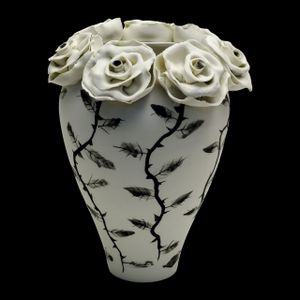
Elica Studio > Styling
Name: ROSAS Material: Porcelain, glaze, oxides Finishing: Matte Sizes (cm): Approx. 24 (height) × 29 (diameter/width at widest point) Weight (g): ~2300 Designed in: 2000 Collection: Naturalia Lead Time: 30 days Description: The ROSAS vase, an exquisitely crafted and poetically evocative piece from Elica Studio's celebrated "Naturalia" collection, offers a profound artistic interpretation of the timeless rose, masterfully integrated into a functional yet sculptural form. Designed in 2000, this unique object transcends conventional decor, serving as a powerful sculptural element that brings a sense of refined artistry, natural elegance, and subtle drama to any interior. It is an ideal choice for interior designers seeking to infuse spaces with a blend of classic floral charm, contemporary conceptual depth, and an undeniable artistic presence. Masterfully crafted from fine porcelain, the ROSAS vase is characterized by its rich textural contrasts and monochromatic palette. The entire piece is finished with a sophisticated matte coating, achieved through the expert application of glazes and oxides, which lends it an understated elegance and a soft, tactile appeal. As vividly illustrated in the accompanying image, the vase features a graceful, tapering cylindrical form, subtly flaring towards the top. What truly defines this creation is the breathtaking three-dimensional sculpting of numerous white roses that encircle and crown its entire rim, forming a lush, continuous garland of blooms. Each rose is meticulously rendered with intricate details, from the delicate layering of petals to the subtle undulations that give them a lifelike quality. These sculpted white roses stand in striking contrast to the body of the vase, which is adorned with bold, hand-drawn or applied patterns of dark, thorny vines. These black thorny motifs crawl up from the base of the vase, reaching towards the pristine white roses, creating a powerful visual tension between beauty and danger, fragility and resilience. This deliberate juxtaposition of the delicate, soft roses and the stark, sharp thorns speaks to the complex nature of beauty itself, making the piece not just decorative but deeply symbolic. The monochromatic scheme further accentuates the forms and textures, allowing the artistic narrative to take center stage. The ROSAS vase, with its unique blend of classical floral motifs, symbolic contrasts, and exquisite sculptural form, offers remarkable versatility for interior designers. It can serve as a stunning standalone art piece, commanding attention on a console table, a credenza, or a prominent pedestal. While capable of holding flora, its inherent artistic merit allows it to function purely as a sculptural object, an art piece in its own right. Its aesthetic is particularly well-suited for adding a touch of sophisticated naturalism to minimalist interiors, enhancing a romantic or art-deco inspired space, or serving as a conversation starter in a modern, avant-garde setting. Belonging to the "Naturalia" collection, it connects to the raw, untamed beauty of the natural world, interpreted through a lens of refined artistry. With dimensions of approximately 24 cm in height and 29 cm in width at its widest point, and weighing around 2300 grams, the ROSAS vase possesses a significant yet manageable presence. Its unique form and captivating aesthetic make it an ideal feature for a high-end residential living area, a boutique hotel lounge, or a sophisticated commercial space. Designed in 2000, the ROSAS vase showcases Elica Studio's innovative approach to ceramic art, ensuring its enduring relevance in today's design landscape. For interior designers seeking to imbue their projects with unique character, a sense of refined artistry, and a touch of engaging conceptual depth, the ROSAS vase is an unparalleled choice. Its distinctive aesthetic, thoughtful integration of form and symbolism, and captivating visual impact position it as an investment piece that will resonate with clients who appreciate bespoke quality, enduring design, and a connection to the artistic exploration of nature's profound and multifaceted beauty. With a standard lead time of 30 days, incorporating this exceptional sculpture into project timelines is straightforward, promising to deliver a compelling visual experience that enhances the overall ambiance of any sophisticated interior.
Policroma Cipria
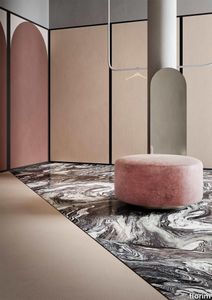
florim > Wall Paint
Recurring geometries, combinations of figures. Marble and marmorino plaster: comparison and dialogue. The collection is completed by a linear listello tile with the motif of a sequence of vertical rectangular blocks, which can be combined with the slabs to further enrich compositions involving continuous ceramic surfaces cladding.<br /><br />"Another reference is the use of Italian marbles on the verge of extinction, rare marbles such as Rosa Valtoce, the marble used in Milan Cathedral."<br />Cristina Celestino Cristina Celestino's smartphone contains a folder of images entitled "Milan". Photographs that are more like notes. Photographs of architectural features, materials or details of shapes encountered by chance during a walk, but they cannot be described as merely a vague "source of inspiration". This filing system, created in response to a fleeting instinct, is an integral part of the method of work adopted by the architect and designer, who starts off without preconceptions "“ or "free", as she puts it before drawing inputs from a vast world of references, from Hermès scarves to the works of the great Masters (in the specific case of Policroma). This accumulation, partly spontaneous and party the outcome of in-depth historical knowledge and study, naturally activates a process of synthesis and personal interpretation common to all Cristina Celestino's output.<br /><br /><br />The wall covering collection designed for Cedit was no exception, although in this case the designer was dealing with a project with variable dimensions, reaching up even to the architectural scale. In her own distinctive way, she combined a variety of references. Adolf Loos's passion for coloured types of marble, and Cipollino in particular. Carlo Scarpa's angular metal frames and Marmorino plaster in Venice. The French fashion house's square silk scarves. The entrance halls of Milan palazzos, Gio Ponti, the city's Cathedral. All expressed in the designer's own language: well balanced geometrical forms, subtle colours (shades similar to those of Scarpa himself), an effortless, almost restrained, playful elegance. The mood is that of the homes of the enlightened bourgeoisie who shaped the history of Milan, Celestino's adoptive city and an endless source of inputs. She has worked its interiors, including some of the least expected a 1928 tram, the historic Cucchi confectionery store hybridising her own style with the existing context. An imitative effect which is also the key to the meaning of the new Policroma collection: the marble varieties replicated using the Cedit technology are all from Italian quarries that are virtually "worked out". This revives an increasingly rare material as a "living" presence, in a different form which makes no claim to replace the natural original. Quite the contrary, Celestino immediately states her intention to imitate, by combining marble and Marmorino plaster in some variants with a contrasting frame (a typical feature for her, just as it was for Scarpa), and evoking the centuries-old marble-imitating scagliola plasterwork with a contemporary formula.<br /><br /><br />The types of marble chosen are central to the project's character. Verde Alpi, a favourite with Gio Ponti and often found in Milan entrance halls, features tightly packed patterning. Breccia Capraia, still found in a very few places in Tuscany, has a white background with just a few veins. Cipollino, in the special Ondulato variety in green and red, is patterned with spirals. Rosa Valtoce, on the other hand, was used by the "Veneranda Fabbrica" guild to build Milan Cathedral. It is an iconic stone with dramatic stripes, popular in the past; it is now sourced from one very small quarry in Piedmont which has been virtually abandoned.<br /> The many different elements that make up the Policroma collection all reflect the importance of craftsmanship to Cristina Celestino's design style: the modules can be freely mixed and combined, for example to create a concave or convex semicircle, or for the large-scale replication of small features initially conceived as trims, functional details transformed into a dominant motif.There is a return to the theme of the interior, a large or small protected space, conceived as suspended in space and time yet also reassuring and protective. It is designed through its coverings in a stark yet not minimalist way, with intelligence and with no overreaching artistic ambitions. An understated space and an extremely stylish declaration. In Milan style, of course.
Policroma Valtoce

florim > Wall tile-stone-brick
Recurring geometries, combinations of figures. Marble and marmorino plaster: comparison and dialogue. The collection is completed by a linear listello tile with the motif of a sequence of vertical rectangular blocks, which can be combined with the slabs to further enrich compositions involving continuous ceramic surfaces cladding.<br /><br />"Another reference is the use of Italian marbles on the verge of extinction, rare marbles such as Rosa Valtoce, the marble used in Milan Cathedral."<br />Cristina Celestino Cristina Celestino's smartphone contains a folder of images entitled "Milan". Photographs that are more like notes. Photographs of architectural features, materials or details of shapes encountered by chance during a walk, but they cannot be described as merely a vague "source of inspiration". This filing system, created in response to a fleeting instinct, is an integral part of the method of work adopted by the architect and designer, who starts off without preconceptions "“ or "free", as she puts it before drawing inputs from a vast world of references, from Hermès scarves to the works of the great Masters (in the specific case of Policroma). This accumulation, partly spontaneous and party the outcome of in-depth historical knowledge and study, naturally activates a process of synthesis and personal interpretation common to all Cristina Celestino's output.<br /><br /><br />The wall covering collection designed for Cedit was no exception, although in this case the designer was dealing with a project with variable dimensions, reaching up even to the architectural scale. In her own distinctive way, she combined a variety of references. Adolf Loos's passion for coloured types of marble, and Cipollino in particular. Carlo Scarpa's angular metal frames and Marmorino plaster in Venice. The French fashion house's square silk scarves. The entrance halls of Milan palazzos, Gio Ponti, the city's Cathedral. All expressed in the designer's own language: well balanced geometrical forms, subtle colours (shades similar to those of Scarpa himself), an effortless, almost restrained, playful elegance. The mood is that of the homes of the enlightened bourgeoisie who shaped the history of Milan, Celestino's adoptive city and an endless source of inputs. She has worked its interiors, including some of the least expected a 1928 tram, the historic Cucchi confectionery store hybridising her own style with the existing context. An imitative effect which is also the key to the meaning of the new Policroma collection: the marble varieties replicated using the Cedit technology are all from Italian quarries that are virtually "worked out". This revives an increasingly rare material as a "living" presence, in a different form which makes no claim to replace the natural original. Quite the contrary, Celestino immediately states her intention to imitate, by combining marble and Marmorino plaster in some variants with a contrasting frame (a typical feature for her, just as it was for Scarpa), and evoking the centuries-old marble-imitating scagliola plasterwork with a contemporary formula.<br /><br /><br />The types of marble chosen are central to the project's character. Verde Alpi, a favourite with Gio Ponti and often found in Milan entrance halls, features tightly packed patterning. Breccia Capraia, still found in a very few places in Tuscany, has a white background with just a few veins. Cipollino, in the special Ondulato variety in green and red, is patterned with spirals. Rosa Valtoce, on the other hand, was used by the "Veneranda Fabbrica" guild to build Milan Cathedral. It is an iconic stone with dramatic stripes, popular in the past; it is now sourced from one very small quarry in Piedmont which has been virtually abandoned.<br /> The many different elements that make up the Policroma collection all reflect the importance of craftsmanship to Cristina Celestino's design style: the modules can be freely mixed and combined, for example to create a concave or convex semicircle, or for the large-scale replication of small features initially conceived as trims, functional details transformed into a dominant motif.There is a return to the theme of the interior, a large or small protected space, conceived as suspended in space and time yet also reassuring and protective. It is designed through its coverings in a stark yet not minimalist way, with intelligence and with no overreaching artistic ambitions. An understated space and an extremely stylish declaration. In Milan style, of course.
Policroma Breccia

florim > Wall tile-stone-brick
Recurring geometries, combinations of figures. Marble and marmorino plaster: comparison and dialogue. The collection is completed by a linear listello tile with the motif of a sequence of vertical rectangular blocks, which can be combined with the slabs to further enrich compositions involving continuous ceramic surfaces cladding.<br /><br />"Another reference is the use of Italian marbles on the verge of extinction, rare marbles such as Rosa Valtoce, the marble used in Milan Cathedral."<br />Cristina Celestino Cristina Celestino's smartphone contains a folder of images entitled "Milan". Photographs that are more like notes. Photographs of architectural features, materials or details of shapes encountered by chance during a walk, but they cannot be described as merely a vague "source of inspiration". This filing system, created in response to a fleeting instinct, is an integral part of the method of work adopted by the architect and designer, who starts off without preconceptions "“ or "free", as she puts it before drawing inputs from a vast world of references, from Hermès scarves to the works of the great Masters (in the specific case of Policroma). This accumulation, partly spontaneous and party the outcome of in-depth historical knowledge and study, naturally activates a process of synthesis and personal interpretation common to all Cristina Celestino's output.<br /><br /><br />The wall covering collection designed for Cedit was no exception, although in this case the designer was dealing with a project with variable dimensions, reaching up even to the architectural scale. In her own distinctive way, she combined a variety of references. Adolf Loos's passion for coloured types of marble, and Cipollino in particular. Carlo Scarpa's angular metal frames and Marmorino plaster in Venice. The French fashion house's square silk scarves. The entrance halls of Milan palazzos, Gio Ponti, the city's Cathedral. All expressed in the designer's own language: well balanced geometrical forms, subtle colours (shades similar to those of Scarpa himself), an effortless, almost restrained, playful elegance. The mood is that of the homes of the enlightened bourgeoisie who shaped the history of Milan, Celestino's adoptive city and an endless source of inputs. She has worked its interiors, including some of the least expected a 1928 tram, the historic Cucchi confectionery store hybridising her own style with the existing context. An imitative effect which is also the key to the meaning of the new Policroma collection: the marble varieties replicated using the Cedit technology are all from Italian quarries that are virtually "worked out". This revives an increasingly rare material as a "living" presence, in a different form which makes no claim to replace the natural original. Quite the contrary, Celestino immediately states her intention to imitate, by combining marble and Marmorino plaster in some variants with a contrasting frame (a typical feature for her, just as it was for Scarpa), and evoking the centuries-old marble-imitating scagliola plasterwork with a contemporary formula.<br /><br /><br />The types of marble chosen are central to the project's character. Verde Alpi, a favourite with Gio Ponti and often found in Milan entrance halls, features tightly packed patterning. Breccia Capraia, still found in a very few places in Tuscany, has a white background with just a few veins. Cipollino, in the special Ondulato variety in green and red, is patterned with spirals. Rosa Valtoce, on the other hand, was used by the "Veneranda Fabbrica" guild to build Milan Cathedral. It is an iconic stone with dramatic stripes, popular in the past; it is now sourced from one very small quarry in Piedmont which has been virtually abandoned.<br /> The many different elements that make up the Policroma collection all reflect the importance of craftsmanship to Cristina Celestino's design style: the modules can be freely mixed and combined, for example to create a concave or convex semicircle, or for the large-scale replication of small features initially conceived as trims, functional details transformed into a dominant motif.There is a return to the theme of the interior, a large or small protected space, conceived as suspended in space and time yet also reassuring and protective. It is designed through its coverings in a stark yet not minimalist way, with intelligence and with no overreaching artistic ambitions. An understated space and an extremely stylish declaration. In Milan style, of course.
Policroma Lichene

florim > Wall Paint
Recurring geometries, combinations of figures. Marble and marmorino plaster: comparison and dialogue. The collection is completed by a linear listello tile with the motif of a sequence of vertical rectangular blocks, which can be combined with the slabs to further enrich compositions involving continuous ceramic surfaces cladding.<br /><br />"Another reference is the use of Italian marbles on the verge of extinction, rare marbles such as Rosa Valtoce, the marble used in Milan Cathedral."<br />Cristina Celestino Cristina Celestino's smartphone contains a folder of images entitled "Milan". Photographs that are more like notes. Photographs of architectural features, materials or details of shapes encountered by chance during a walk, but they cannot be described as merely a vague "source of inspiration". This filing system, created in response to a fleeting instinct, is an integral part of the method of work adopted by the architect and designer, who starts off without preconceptions "“ or "free", as she puts it before drawing inputs from a vast world of references, from Hermès scarves to the works of the great Masters (in the specific case of Policroma). This accumulation, partly spontaneous and party the outcome of in-depth historical knowledge and study, naturally activates a process of synthesis and personal interpretation common to all Cristina Celestino's output.<br /><br /><br />The wall covering collection designed for Cedit was no exception, although in this case the designer was dealing with a project with variable dimensions, reaching up even to the architectural scale. In her own distinctive way, she combined a variety of references. Adolf Loos's passion for coloured types of marble, and Cipollino in particular. Carlo Scarpa's angular metal frames and Marmorino plaster in Venice. The French fashion house's square silk scarves. The entrance halls of Milan palazzos, Gio Ponti, the city's Cathedral. All expressed in the designer's own language: well balanced geometrical forms, subtle colours (shades similar to those of Scarpa himself), an effortless, almost restrained, playful elegance. The mood is that of the homes of the enlightened bourgeoisie who shaped the history of Milan, Celestino's adoptive city and an endless source of inputs. She has worked its interiors, including some of the least expected a 1928 tram, the historic Cucchi confectionery store hybridising her own style with the existing context. An imitative effect which is also the key to the meaning of the new Policroma collection: the marble varieties replicated using the Cedit technology are all from Italian quarries that are virtually "worked out". This revives an increasingly rare material as a "living" presence, in a different form which makes no claim to replace the natural original. Quite the contrary, Celestino immediately states her intention to imitate, by combining marble and Marmorino plaster in some variants with a contrasting frame (a typical feature for her, just as it was for Scarpa), and evoking the centuries-old marble-imitating scagliola plasterwork with a contemporary formula.<br /><br /><br />The types of marble chosen are central to the project's character. Verde Alpi, a favourite with Gio Ponti and often found in Milan entrance halls, features tightly packed patterning. Breccia Capraia, still found in a very few places in Tuscany, has a white background with just a few veins. Cipollino, in the special Ondulato variety in green and red, is patterned with spirals. Rosa Valtoce, on the other hand, was used by the "Veneranda Fabbrica" guild to build Milan Cathedral. It is an iconic stone with dramatic stripes, popular in the past; it is now sourced from one very small quarry in Piedmont which has been virtually abandoned.<br /> The many different elements that make up the Policroma collection all reflect the importance of craftsmanship to Cristina Celestino's design style: the modules can be freely mixed and combined, for example to create a concave or convex semicircle, or for the large-scale replication of small features initially conceived as trims, functional details transformed into a dominant motif.There is a return to the theme of the interior, a large or small protected space, conceived as suspended in space and time yet also reassuring and protective. It is designed through its coverings in a stark yet not minimalist way, with intelligence and with no overreaching artistic ambitions. An understated space and an extremely stylish declaration. In Milan style, of course.
Policroma Cipollino

florim > Wall tile-stone-brick
Recurring geometries, combinations of figures. Marble and marmorino plaster: comparison and dialogue. The collection is completed by a linear listello tile with the motif of a sequence of vertical rectangular blocks, which can be combined with the slabs to further enrich compositions involving continuous ceramic surfaces cladding.<br /><br />"Another reference is the use of Italian marbles on the verge of extinction, rare marbles such as Rosa Valtoce, the marble used in Milan Cathedral."<br />Cristina Celestino Cristina Celestino's smartphone contains a folder of images entitled "Milan". Photographs that are more like notes. Photographs of architectural features, materials or details of shapes encountered by chance during a walk, but they cannot be described as merely a vague "source of inspiration". This filing system, created in response to a fleeting instinct, is an integral part of the method of work adopted by the architect and designer, who starts off without preconceptions "“ or "free", as she puts it before drawing inputs from a vast world of references, from Hermès scarves to the works of the great Masters (in the specific case of Policroma). This accumulation, partly spontaneous and party the outcome of in-depth historical knowledge and study, naturally activates a process of synthesis and personal interpretation common to all Cristina Celestino's output.<br /><br /><br />The wall covering collection designed for Cedit was no exception, although in this case the designer was dealing with a project with variable dimensions, reaching up even to the architectural scale. In her own distinctive way, she combined a variety of references. Adolf Loos's passion for coloured types of marble, and Cipollino in particular. Carlo Scarpa's angular metal frames and Marmorino plaster in Venice. The French fashion house's square silk scarves. The entrance halls of Milan palazzos, Gio Ponti, the city's Cathedral. All expressed in the designer's own language: well balanced geometrical forms, subtle colours (shades similar to those of Scarpa himself), an effortless, almost restrained, playful elegance. The mood is that of the homes of the enlightened bourgeoisie who shaped the history of Milan, Celestino's adoptive city and an endless source of inputs. She has worked its interiors, including some of the least expected a 1928 tram, the historic Cucchi confectionery store hybridising her own style with the existing context. An imitative effect which is also the key to the meaning of the new Policroma collection: the marble varieties replicated using the Cedit technology are all from Italian quarries that are virtually "worked out". This revives an increasingly rare material as a "living" presence, in a different form which makes no claim to replace the natural original. Quite the contrary, Celestino immediately states her intention to imitate, by combining marble and Marmorino plaster in some variants with a contrasting frame (a typical feature for her, just as it was for Scarpa), and evoking the centuries-old marble-imitating scagliola plasterwork with a contemporary formula.<br /><br /><br />The types of marble chosen are central to the project's character. Verde Alpi, a favourite with Gio Ponti and often found in Milan entrance halls, features tightly packed patterning. Breccia Capraia, still found in a very few places in Tuscany, has a white background with just a few veins. Cipollino, in the special Ondulato variety in green and red, is patterned with spirals. Rosa Valtoce, on the other hand, was used by the "Veneranda Fabbrica" guild to build Milan Cathedral. It is an iconic stone with dramatic stripes, popular in the past; it is now sourced from one very small quarry in Piedmont which has been virtually abandoned.<br /> The many different elements that make up the Policroma collection all reflect the importance of craftsmanship to Cristina Celestino's design style: the modules can be freely mixed and combined, for example to create a concave or convex semicircle, or for the large-scale replication of small features initially conceived as trims, functional details transformed into a dominant motif.There is a return to the theme of the interior, a large or small protected space, conceived as suspended in space and time yet also reassuring and protective. It is designed through its coverings in a stark yet not minimalist way, with intelligence and with no overreaching artistic ambitions. An understated space and an extremely stylish declaration. In Milan style, of course.
Policroma Alpi

florim > Wall tile-stone-brick
Recurring geometries, combinations of figures. Marble and marmorino plaster: comparison and dialogue. The collection is completed by a linear listello tile with the motif of a sequence of vertical rectangular blocks, which can be combined with the slabs to further enrich compositions involving continuous ceramic surfaces cladding.<br /><br />"Another reference is the use of Italian marbles on the verge of extinction, rare marbles such as Rosa Valtoce, the marble used in Milan Cathedral."<br />Cristina Celestino Cristina Celestino's smartphone contains a folder of images entitled "Milan". Photographs that are more like notes. Photographs of architectural features, materials or details of shapes encountered by chance during a walk, but they cannot be described as merely a vague "source of inspiration". This filing system, created in response to a fleeting instinct, is an integral part of the method of work adopted by the architect and designer, who starts off without preconceptions "“ or "free", as she puts it before drawing inputs from a vast world of references, from Hermès scarves to the works of the great Masters (in the specific case of Policroma). This accumulation, partly spontaneous and party the outcome of in-depth historical knowledge and study, naturally activates a process of synthesis and personal interpretation common to all Cristina Celestino's output.<br /><br /><br />The wall covering collection designed for Cedit was no exception, although in this case the designer was dealing with a project with variable dimensions, reaching up even to the architectural scale. In her own distinctive way, she combined a variety of references. Adolf Loos's passion for coloured types of marble, and Cipollino in particular. Carlo Scarpa's angular metal frames and Marmorino plaster in Venice. The French fashion house's square silk scarves. The entrance halls of Milan palazzos, Gio Ponti, the city's Cathedral. All expressed in the designer's own language: well balanced geometrical forms, subtle colours (shades similar to those of Scarpa himself), an effortless, almost restrained, playful elegance. The mood is that of the homes of the enlightened bourgeoisie who shaped the history of Milan, Celestino's adoptive city and an endless source of inputs. She has worked its interiors, including some of the least expected a 1928 tram, the historic Cucchi confectionery store hybridising her own style with the existing context. An imitative effect which is also the key to the meaning of the new Policroma collection: the marble varieties replicated using the Cedit technology are all from Italian quarries that are virtually "worked out". This revives an increasingly rare material as a "living" presence, in a different form which makes no claim to replace the natural original. Quite the contrary, Celestino immediately states her intention to imitate, by combining marble and Marmorino plaster in some variants with a contrasting frame (a typical feature for her, just as it was for Scarpa), and evoking the centuries-old marble-imitating scagliola plasterwork with a contemporary formula.<br /><br /><br />The types of marble chosen are central to the project's character. Verde Alpi, a favourite with Gio Ponti and often found in Milan entrance halls, features tightly packed patterning. Breccia Capraia, still found in a very few places in Tuscany, has a white background with just a few veins. Cipollino, in the special Ondulato variety in green and red, is patterned with spirals. Rosa Valtoce, on the other hand, was used by the "Veneranda Fabbrica" guild to build Milan Cathedral. It is an iconic stone with dramatic stripes, popular in the past; it is now sourced from one very small quarry in Piedmont which has been virtually abandoned.<br /> The many different elements that make up the Policroma collection all reflect the importance of craftsmanship to Cristina Celestino's design style: the modules can be freely mixed and combined, for example to create a concave or convex semicircle, or for the large-scale replication of small features initially conceived as trims, functional details transformed into a dominant motif.There is a return to the theme of the interior, a large or small protected space, conceived as suspended in space and time yet also reassuring and protective. It is designed through its coverings in a stark yet not minimalist way, with intelligence and with no overreaching artistic ambitions. An understated space and an extremely stylish declaration. In Milan style, of course.
H-26 RARA NIGRA AVIS
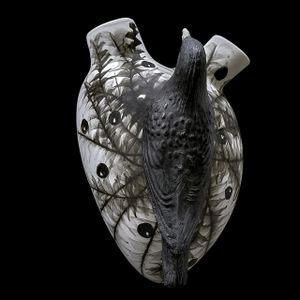
Elica Studio > Styling
Name: H-26 RARA NIGRA AVIS Material: Porcelain, engobes, oxides, glaze Finishing: Matte Sizes (cm): 24 x 17 x 18 Weight (g): 960 Designed in: 2015 Collection: In alto i Cuori The H-26 RARA NIGRA AVIS is a sculptural porcelain object with a moody, visceral elegance. Rendered in deep grey and black tones with layered engobes and oxides, its matte surface evokes a raw, tactile emotion. A light touch of gloss accentuates selected areas, enhancing texture without compromising the overall restraint of the finish. The shape loosely follows the contours of a human heart, but with a more stylised and expressive interpretation. Sharp protrusions and organic folds create visual drama, while the compact body anchors it physically. Despite its compact dimensions, the piece has real presence thanks to its bold silhouette and dense, handcrafted structure. Colour-wise, the sculpture leans toward a dark neutral palette — blackened porcelain with mineral undertones, enriched by the natural irregularities of hand-finishing. This allows it to sit powerfully in minimalist, industrial, or contemporary interiors where contrast and material honesty are part of the design narrative. Interior designers can use the RARA NIGRA AVIS as a sculptural styling piece to introduce emotional weight, artisanal character, and layered texture into curated settings. Whether placed on a console in a lobby, a shelf in a gallery-like living space, or integrated into a poetic vignette, it brings a grounded sense of artistry. Part of the In alto i Cuori collection, this work reflects on themes of resilience, identity, and imperfection — making it a fitting companion for spaces that speak quietly but deeply. It's not just a decorative object; it's a symbol, and a sculptural punctuation mark within any meaningful interior composition.
TS 22 RET
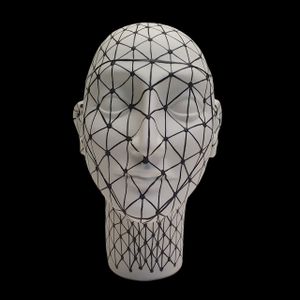
Elica Studio > Styling
TS 22 RET Material Porcelain, engobes, oxides, glaze Finishing Matte Sizes (cm) 2025 Weight (g) 850 Designed in 2022 Collection Anatomika Lead Time: 30 days Description: The TS22 RETE, a distinguished piece from the Totemica Collection, is an exemplary work of fine porcelain art designed to captivate and inspire. Standing approximately 30 cm tall with a width of 16 cm and a depth of 12 cm, and weighing around 1100g, this sculpture masterfully combines a serene matte white glaze with an intricate black ink-style illustration that mimics a geometric mesh or network across its surface. Created in 2022, the TS22 RETE offers interior designers a unique opportunity to infuse spaces with a sense of modern intellectualism and artistic flair, bridging the gap between digital aesthetics and tangible artistry. For interior designers aiming to create sophisticated and conceptually rich environments, the TS22 RETE is an invaluable asset. Its striking visual pattern, reminiscent of a digital wireframe or a complex geometric grid, offers a contemporary twist on classic sculptural forms. This piece can serve as a compelling focal point in a minimalist living room, adding depth and texture without overwhelming the space. Imagine it placed on a sleek, dark wood console table, where the stark contrast of white and black creates a powerful visual statement. In a modern office or a creative studio, the TS22 RETE can embody innovation and interconnectedness, resonating with professionals who appreciate art that stimulates thought and conversation. Its graphic nature makes it particularly suitable for spaces embracing an industrial chic, futuristic, or even a deconstructivist design aesthetic. The artistic concept behind the TS22 RETE draws from themes of structure, connection, and the underlying framework of existence, making it more than just a decorative object. It invites viewers to ponder the seen and unseen networks that shape our world, offering a subtle yet profound intellectual layer to any interior. For hospitality projects, such as boutique hotels or trendy cafes, this sculpture can contribute to a unique brand identity, creating memorable visual experiences for guests. Its intriguing pattern ensures it remains engaging, encouraging repeated glances and sparking curiosity. In a high-end retail setting, it could be used in display windows or within product showcases to evoke a sense of precision, modernity, and artistic curation, aligning with luxury brands that value thoughtful design. Practical considerations for interior designers are well-addressed by the TS22 RETE. Crafted from durable fine porcelain, it promises longevity and resilience, making it a sustainable choice for high-traffic areas or long-term installations. The matte white glaze is easy to maintain, and the black ink illustration is fixed, ensuring the design remains crisp and vibrant over time. A lead time of 30 days allows for efficient project planning and integration into design schemes. Its stable weight and balanced dimensions make it versatile for various placements, from custom-built shelving units to open-plan display areas, allowing designers creative freedom in its application. The piece’s inherent stability ensures it can be positioned safely and securely in diverse settings. In terms of SEO, keywords pertinent to interior design professionals searching for such unique pieces include "geometric sculpture," "modern porcelain art," "wireframe design decor," "abstract head sculpture," "black and white decor," "contemporary art for interiors," and "network pattern sculpture." These terms accurately describe its aesthetic and conceptual attributes, ensuring it appears in relevant searches for designers seeking to curate distinctive and intellectually stimulating spaces. The timeless monochromatic palette of black and white also broadens its appeal, making it adaptable to a wide range of color schemes and design philosophies, from bold and dramatic to subtle and serene. Ultimately, the TS22 RETE from the Totemica Collection is a sophisticated and thought-provoking piece that transcends mere decoration. It is a strategic design element capable of elevating the intellectual and aesthetic value of any interior. Its unique blend of artistic depth, modern visual appeal, and practical design attributes makes it an indispensable tool for interior designers aiming to create truly exceptional, memorable, and conceptually rich environments for their discerning clients. This sculpture is not just seen; it is experienced and contemplated, leaving a lasting impression on all who encounter it.
Tape
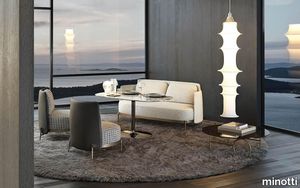
minotti > Sofa
Signed by the eclectic Japanese studio Nendo, directed by Oki Sato, Tape is a collection of seats with a strong personality, characterised by the light silhouette, and consists of a comprehensive range of models: armchair with and without armrests, lounge armchair, bergère, two and three seater sofa and ottoman. With his distinctive ironic approach, the designer overturns the traditional idea of the support feet that come out of the body of the seat, placing them externally to the structure. Tape owes its name to the couture detail, conceived as a piece of ribbon that holds the Bronze-coloured metal feet. A real tribute by Nendo to the sartorial experience of Minotti. The soft curve of the shell, which designs the armrest and that accommodates the soft back cushion, highlights the pure and enveloping line of the armchair. Customizable in a wide range of leather and fabric coverings, it presents two possible sets of pairings. In one version, the fabric covers the back and the seat cushion, while the shell and the tape detail are in leather of the same colour; in the other, the textile envelops the back, the seat cushion and the entire shell, while the tape detail is in Bronze-coloured saddle-hide. With its firm formal identity and its impeccable proportions, Tape becomes the protagonist of the space that welcomes it, both in residential and hospitality contexts.
1034 Cordoba Black & White
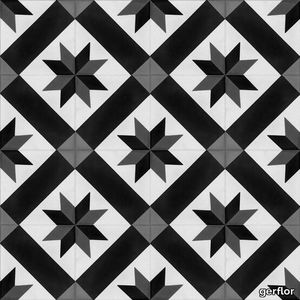
gerflor > Floor plank
This collection features planks and tiles with a dozen imitation designs, including wood parquet flooring ("Puzzle"), concrete and cement tiles ("Provence Blue"). Senso Premium Easy is an open invitation to give your floor covering a personalised touch by mixing and matching the different designs to your heart's content! All the models in this collection can be combined together, meaning that you can separate different spaces within the home or even create original designs. Give your floor a makeover and turn it into your very own pride and joy.With Gerflor's Senso Premium Easy collection, there is no need to glue planks and tiles to the floor or clip them together. These loose-lay planks and tiles rely on their own weight when it comes to fitting and staying in place! They can even be repositioned if you make a mistake This removable floor covering is so quick and easy to fit that you can actually do it yourself. A compatible primer must first be applied to the substrate, such as Bostik Universal Primer. Gerflor Senso Premium Easy is quick and easy to clean with a broom or vacuum cleaner. To remove the most stubborn stains, wipe with a well-wrung damp mop and some neutral detergent. Unlike a real parquet floor, you will not need any wax or oil to keep your floor covering sparkling and looking brand new!The planks and tiles in the Senso Premium Easy collection offer considerable stability, a non-slip surface and superior resistance to wear, impacts, scratches and residual indentation. Senso Premium Easy is ideal for large shops, retail premises, restaurants, offices and obviously every room in your home. This product is also perfectly resistant to water and moisture, so look no further when looking to renovate your home's wet areas (bathrooms, kitchens, etc.).planks and tiles are 100% recyclable as part of the brand's determination to protect the environment, which includes upcycling offcuts (click here to find out more).178 x 1219 mm, 228 x 1492 mm and 457 x 914 mm;
Ballare Table
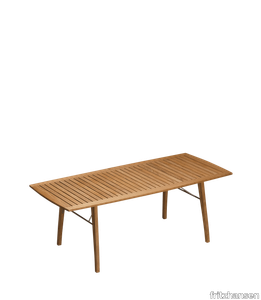
fritzhansen > Table
The Ballare series of elegant outdoor furniture is crafted for lasting beauty. Blurring the lines between indoor and outdoor living, the minimalist designs feature soft curves and considered details that make them a delight to look at as well as to use. Designed by Danish designer Jakob Berg. Accommodating gatherings small and large, the Ballare Table can be extended to almost three metres in length when using both of the included extension leaves, making it ideal for unexpected guests and impromptu meals.
Quadrado "Table"
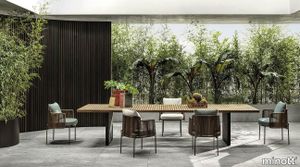
minotti > Table
Rationalist, minimal, designed by combining different materials and textures that enhance its linear shapes, the table features the element that characterises the Quadrado family on its top: a duckboard pattern. Teak duckboard, used in the yachting industry to facilitate the outflow of water, was introduced in 2018 as a modular element of the structured Quadrado seating system created by the Brazilian designer. The table comes in three dimensions, and features a top set on aluminium legs, designed as two panels that cross it on the short side. It sports a striking Lava Stone Powder finish, generating an interesting contrast between the surfaces and the Teak wood of the top. A number of plug-in accessories, such as the candle-holder and the Lava Stone tray, mean the table can be set to match the occasion. The Quadrado table can be used in different arrangements, perhaps forming part of a domino sequence or designing a frame round the trunk of a tree, as suggested by Marcio Kogan, as always in pursuit of an ideal relationship between his designs and the nature surrounding them.
Miniatures Hill House 1
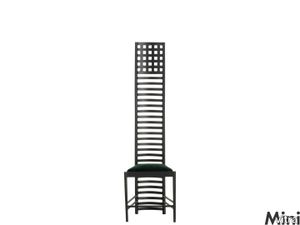
vitra > Styling
Charles Rennie Mackintosh was one of the great representatives of Art Nouveau. Together with his wife Margaret McDonald, her sister Frances, and his brother-in-law Herbert McNair, he developed an original style that set itself apart from the decorative floral style of Jugendstil. The group's geometric, almost cubist designs for furniture show the influence of Japanese spacial concepts and are distinguished by their elongated, severe forms. A typical aspect of their work is a formal scheme based on horizontal and vertical lines, occasionally combined with slightly curved linear ornamentation. <br/><br/>Hill House 1 marks a new phase in the work of Mackintosh. The chair´s strict geometry recalls the Ladderback Chairs of the Shakers and clearly differs from the organic or feminine forms of early designs. It was made for the house of a Scottish publisher and his wife and functioned more as part of an artistic environment than as a piece of furniture for everyday use. The chair was assigned a set place in the bedroom of the couple, where it fulfilled a purely decorative function. The extended back, first used by Mackintosh in 1897, is a motif that appears repeatedly in his chairs and gives them an unmistakable quality.
Tesori Broccato grigio
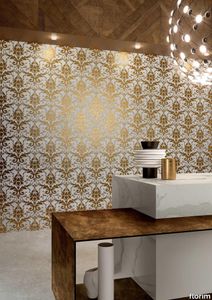
florim > Wallcovering
East and West, a synthesis archieved through Italian taste. «My work often takes me to far-off lands, also remote in terms of their culture and traditions. Even without my being aware of it, I then metabolise these traditions and include them in the designs I subsequently produce.» Matteo Nunziati <p>"It is the architect's task to create a warm, livable space. Carpets are warm and livable. He decides for this reason to spread one carpet on the floor and to hang up four to form the four walls. But you cannot build a house out of carpets. Both the carpet and the floor and the tapestry on the wall required structural frame to hold them in the correct place. To invent this frame is the architect's second task."When Adolf Loos wrote his revolutionary essay on the "principle of cladding" in 1898, architecture was just entering the modern age. Building meant imagining structures capable of putting together different materials, but, Loos affirmed, it must also respect their individual characteristics. "Every material possesses a formal language which belongs to it alone and no material can take on the forms proper to another", the Austrian master therefore maintained. And there is no doubt that the spirit of these words extended throughout most Twentieth Century architecture, regardless of its location or style. When we look at Matteo Nunziati's designs for the CEDIT Tesori collection, we seem to be seeing geometrical purity and attention to detail at the service of a new "truth" of material. Because Matteo Nunziati views ceramics as a form of fabric.<br /> The woven patterns he imagines for the various styles in his collection "“ from Arabian to damask to more geometrical motifs "“ constantly seek to provide the soft, iridescent look of time-worn linen. In them, ceramics are raised from the status of poor relation of marble to become a luxury wall covering in their own right: almost a wallpaper, suitable however for both floors and walls, and an absolutely versatile material. No longer only for beautifying bathrooms, they can create new moods in every room of the house (and elsewhere) starting from the living-room. Naturally, the revolution has been mainly technological. The large slabs produced by CEDIT are more than 3 metres tall, and since they eliminate the serial repetition typical of conventional tiles, they generate a new relationship between the surface and its decoration. However, Nunziati does not use this to create, artist-like, a more eye-catching decorative composition that emphasises the slab's dimensions. Quite the opposite; the patterns he offers us attempt to break down what is left of the boundaries between substrates. In particular, the Arabian and damask styles, in the version with "timeworn" patterning, convey the idea of the ceramic slab as an abstract, almost non-existent material which melts into the decorative motif applied to it, in a kind of pure wall covering.<br /> Through the patient selection of geometrical motifs and tests to verify their suitability for application to ceramic slabs, Nunziati aims to achieve a new material rather than a mere decoration, making this clear by also exploring its tactile dimension, with gouged and relief motifs. His "principle of coverings" therefore relates to ceramics' essence rather than their image: highlighting the versatility which, as we all know, has made ceramics an absolute material, a kind of cement that incorporates structure and finish in a virtually infinite range of applications. This is clearly indicated by the reference to the mashrabiya, a term meaning place where people drink in Arabic, which in Arabian architecture originally referred to the kind of veranda where people used to meet and rest, and over time has come to mean the wooden gratings that screened these places from the sun. Inspired by his trips to the Middle East, for Nunziati the geometric patterns of the mashrabiya become both an outline of his method of work and the form of what in fact becomes the key element in a new idea of space: a real location conceived around a strong, livable surface in which physical substance and decoration overlap to the point where they merge.</p>
Tesori Lino bianco

florim > Wallcovering
East and West, a synthesis archieved through Italian taste. «My work often takes me to far-off lands, also remote in terms of their culture and traditions. Even without my being aware of it, I then metabolise these traditions and include them in the designs I subsequently produce.» Matteo Nunziati <p>"It is the architect's task to create a warm, livable space. Carpets are warm and livable. He decides for this reason to spread one carpet on the floor and to hang up four to form the four walls. But you cannot build a house out of carpets. Both the carpet and the floor and the tapestry on the wall required structural frame to hold them in the correct place. To invent this frame is the architect's second task."When Adolf Loos wrote his revolutionary essay on the "principle of cladding" in 1898, architecture was just entering the modern age. Building meant imagining structures capable of putting together different materials, but, Loos affirmed, it must also respect their individual characteristics. "Every material possesses a formal language which belongs to it alone and no material can take on the forms proper to another", the Austrian master therefore maintained. And there is no doubt that the spirit of these words extended throughout most Twentieth Century architecture, regardless of its location or style. When we look at Matteo Nunziati's designs for the CEDIT Tesori collection, we seem to be seeing geometrical purity and attention to detail at the service of a new "truth" of material. Because Matteo Nunziati views ceramics as a form of fabric.<br /> The woven patterns he imagines for the various styles in his collection "“ from Arabian to damask to more geometrical motifs "“ constantly seek to provide the soft, iridescent look of time-worn linen. In them, ceramics are raised from the status of poor relation of marble to become a luxury wall covering in their own right: almost a wallpaper, suitable however for both floors and walls, and an absolutely versatile material. No longer only for beautifying bathrooms, they can create new moods in every room of the house (and elsewhere) starting from the living-room. Naturally, the revolution has been mainly technological. The large slabs produced by CEDIT are more than 3 metres tall, and since they eliminate the serial repetition typical of conventional tiles, they generate a new relationship between the surface and its decoration. However, Nunziati does not use this to create, artist-like, a more eye-catching decorative composition that emphasises the slab's dimensions. Quite the opposite; the patterns he offers us attempt to break down what is left of the boundaries between substrates. In particular, the Arabian and damask styles, in the version with "timeworn" patterning, convey the idea of the ceramic slab as an abstract, almost non-existent material which melts into the decorative motif applied to it, in a kind of pure wall covering.<br /> Through the patient selection of geometrical motifs and tests to verify their suitability for application to ceramic slabs, Nunziati aims to achieve a new material rather than a mere decoration, making this clear by also exploring its tactile dimension, with gouged and relief motifs. His "principle of coverings" therefore relates to ceramics' essence rather than their image: highlighting the versatility which, as we all know, has made ceramics an absolute material, a kind of cement that incorporates structure and finish in a virtually infinite range of applications. This is clearly indicated by the reference to the mashrabiya, a term meaning place where people drink in Arabic, which in Arabian architecture originally referred to the kind of veranda where people used to meet and rest, and over time has come to mean the wooden gratings that screened these places from the sun. Inspired by his trips to the Middle East, for Nunziati the geometric patterns of the mashrabiya become both an outline of his method of work and the form of what in fact becomes the key element in a new idea of space: a real location conceived around a strong, livable surface in which physical substance and decoration overlap to the point where they merge.</p>
Tesori Broccato bianco

florim > Wallcovering
East and West, a synthesis archieved through Italian taste. «My work often takes me to far-off lands, also remote in terms of their culture and traditions. Even without my being aware of it, I then metabolise these traditions and include them in the designs I subsequently produce.» Matteo Nunziati <p>"It is the architect's task to create a warm, livable space. Carpets are warm and livable. He decides for this reason to spread one carpet on the floor and to hang up four to form the four walls. But you cannot build a house out of carpets. Both the carpet and the floor and the tapestry on the wall required structural frame to hold them in the correct place. To invent this frame is the architect's second task."When Adolf Loos wrote his revolutionary essay on the "principle of cladding" in 1898, architecture was just entering the modern age. Building meant imagining structures capable of putting together different materials, but, Loos affirmed, it must also respect their individual characteristics. "Every material possesses a formal language which belongs to it alone and no material can take on the forms proper to another", the Austrian master therefore maintained. And there is no doubt that the spirit of these words extended throughout most Twentieth Century architecture, regardless of its location or style. When we look at Matteo Nunziati's designs for the CEDIT Tesori collection, we seem to be seeing geometrical purity and attention to detail at the service of a new "truth" of material. Because Matteo Nunziati views ceramics as a form of fabric.<br /> The woven patterns he imagines for the various styles in his collection "“ from Arabian to damask to more geometrical motifs "“ constantly seek to provide the soft, iridescent look of time-worn linen. In them, ceramics are raised from the status of poor relation of marble to become a luxury wall covering in their own right: almost a wallpaper, suitable however for both floors and walls, and an absolutely versatile material. No longer only for beautifying bathrooms, they can create new moods in every room of the house (and elsewhere) starting from the living-room. Naturally, the revolution has been mainly technological. The large slabs produced by CEDIT are more than 3 metres tall, and since they eliminate the serial repetition typical of conventional tiles, they generate a new relationship between the surface and its decoration. However, Nunziati does not use this to create, artist-like, a more eye-catching decorative composition that emphasises the slab's dimensions. Quite the opposite; the patterns he offers us attempt to break down what is left of the boundaries between substrates. In particular, the Arabian and damask styles, in the version with "timeworn" patterning, convey the idea of the ceramic slab as an abstract, almost non-existent material which melts into the decorative motif applied to it, in a kind of pure wall covering.<br /> Through the patient selection of geometrical motifs and tests to verify their suitability for application to ceramic slabs, Nunziati aims to achieve a new material rather than a mere decoration, making this clear by also exploring its tactile dimension, with gouged and relief motifs. His "principle of coverings" therefore relates to ceramics' essence rather than their image: highlighting the versatility which, as we all know, has made ceramics an absolute material, a kind of cement that incorporates structure and finish in a virtually infinite range of applications. This is clearly indicated by the reference to the mashrabiya, a term meaning place where people drink in Arabic, which in Arabian architecture originally referred to the kind of veranda where people used to meet and rest, and over time has come to mean the wooden gratings that screened these places from the sun. Inspired by his trips to the Middle East, for Nunziati the geometric patterns of the mashrabiya become both an outline of his method of work and the form of what in fact becomes the key element in a new idea of space: a real location conceived around a strong, livable surface in which physical substance and decoration overlap to the point where they merge.</p>
Tesori Lino grigio

florim > Wallcovering
East and West, a synthesis archieved through Italian taste. «My work often takes me to far-off lands, also remote in terms of their culture and traditions. Even without my being aware of it, I then metabolise these traditions and include them in the designs I subsequently produce.» Matteo Nunziati <p>"It is the architect's task to create a warm, livable space. Carpets are warm and livable. He decides for this reason to spread one carpet on the floor and to hang up four to form the four walls. But you cannot build a house out of carpets. Both the carpet and the floor and the tapestry on the wall required structural frame to hold them in the correct place. To invent this frame is the architect's second task."When Adolf Loos wrote his revolutionary essay on the "principle of cladding" in 1898, architecture was just entering the modern age. Building meant imagining structures capable of putting together different materials, but, Loos affirmed, it must also respect their individual characteristics. "Every material possesses a formal language which belongs to it alone and no material can take on the forms proper to another", the Austrian master therefore maintained. And there is no doubt that the spirit of these words extended throughout most Twentieth Century architecture, regardless of its location or style. When we look at Matteo Nunziati's designs for the CEDIT Tesori collection, we seem to be seeing geometrical purity and attention to detail at the service of a new "truth" of material. Because Matteo Nunziati views ceramics as a form of fabric.<br /> The woven patterns he imagines for the various styles in his collection "“ from Arabian to damask to more geometrical motifs "“ constantly seek to provide the soft, iridescent look of time-worn linen. In them, ceramics are raised from the status of poor relation of marble to become a luxury wall covering in their own right: almost a wallpaper, suitable however for both floors and walls, and an absolutely versatile material. No longer only for beautifying bathrooms, they can create new moods in every room of the house (and elsewhere) starting from the living-room. Naturally, the revolution has been mainly technological. The large slabs produced by CEDIT are more than 3 metres tall, and since they eliminate the serial repetition typical of conventional tiles, they generate a new relationship between the surface and its decoration. However, Nunziati does not use this to create, artist-like, a more eye-catching decorative composition that emphasises the slab's dimensions. Quite the opposite; the patterns he offers us attempt to break down what is left of the boundaries between substrates. In particular, the Arabian and damask styles, in the version with "timeworn" patterning, convey the idea of the ceramic slab as an abstract, almost non-existent material which melts into the decorative motif applied to it, in a kind of pure wall covering.<br /> Through the patient selection of geometrical motifs and tests to verify their suitability for application to ceramic slabs, Nunziati aims to achieve a new material rather than a mere decoration, making this clear by also exploring its tactile dimension, with gouged and relief motifs. His "principle of coverings" therefore relates to ceramics' essence rather than their image: highlighting the versatility which, as we all know, has made ceramics an absolute material, a kind of cement that incorporates structure and finish in a virtually infinite range of applications. This is clearly indicated by the reference to the mashrabiya, a term meaning place where people drink in Arabic, which in Arabian architecture originally referred to the kind of veranda where people used to meet and rest, and over time has come to mean the wooden gratings that screened these places from the sun. Inspired by his trips to the Middle East, for Nunziati the geometric patterns of the mashrabiya become both an outline of his method of work and the form of what in fact becomes the key element in a new idea of space: a real location conceived around a strong, livable surface in which physical substance and decoration overlap to the point where they merge.</p>
Tesori Anelli grigio

florim > Wallcovering
East and West, a synthesis archieved through Italian taste. «My work often takes me to far-off lands, also remote in terms of their culture and traditions. Even without my being aware of it, I then metabolise these traditions and include them in the designs I subsequently produce.» Matteo Nunziati <p>"It is the architect's task to create a warm, livable space. Carpets are warm and livable. He decides for this reason to spread one carpet on the floor and to hang up four to form the four walls. But you cannot build a house out of carpets. Both the carpet and the floor and the tapestry on the wall required structural frame to hold them in the correct place. To invent this frame is the architect's second task."When Adolf Loos wrote his revolutionary essay on the "principle of cladding" in 1898, architecture was just entering the modern age. Building meant imagining structures capable of putting together different materials, but, Loos affirmed, it must also respect their individual characteristics. "Every material possesses a formal language which belongs to it alone and no material can take on the forms proper to another", the Austrian master therefore maintained. And there is no doubt that the spirit of these words extended throughout most Twentieth Century architecture, regardless of its location or style. When we look at Matteo Nunziati's designs for the CEDIT Tesori collection, we seem to be seeing geometrical purity and attention to detail at the service of a new "truth" of material. Because Matteo Nunziati views ceramics as a form of fabric.<br /> The woven patterns he imagines for the various styles in his collection "“ from Arabian to damask to more geometrical motifs "“ constantly seek to provide the soft, iridescent look of time-worn linen. In them, ceramics are raised from the status of poor relation of marble to become a luxury wall covering in their own right: almost a wallpaper, suitable however for both floors and walls, and an absolutely versatile material. No longer only for beautifying bathrooms, they can create new moods in every room of the house (and elsewhere) starting from the living-room. Naturally, the revolution has been mainly technological. The large slabs produced by CEDIT are more than 3 metres tall, and since they eliminate the serial repetition typical of conventional tiles, they generate a new relationship between the surface and its decoration. However, Nunziati does not use this to create, artist-like, a more eye-catching decorative composition that emphasises the slab's dimensions. Quite the opposite; the patterns he offers us attempt to break down what is left of the boundaries between substrates. In particular, the Arabian and damask styles, in the version with "timeworn" patterning, convey the idea of the ceramic slab as an abstract, almost non-existent material which melts into the decorative motif applied to it, in a kind of pure wall covering.<br /> Through the patient selection of geometrical motifs and tests to verify their suitability for application to ceramic slabs, Nunziati aims to achieve a new material rather than a mere decoration, making this clear by also exploring its tactile dimension, with gouged and relief motifs. His "principle of coverings" therefore relates to ceramics' essence rather than their image: highlighting the versatility which, as we all know, has made ceramics an absolute material, a kind of cement that incorporates structure and finish in a virtually infinite range of applications. This is clearly indicated by the reference to the mashrabiya, a term meaning place where people drink in Arabic, which in Arabian architecture originally referred to the kind of veranda where people used to meet and rest, and over time has come to mean the wooden gratings that screened these places from the sun. Inspired by his trips to the Middle East, for Nunziati the geometric patterns of the mashrabiya become both an outline of his method of work and the form of what in fact becomes the key element in a new idea of space: a real location conceived around a strong, livable surface in which physical substance and decoration overlap to the point where they merge.</p>
Tesori Anelli bianco

florim > Wallcovering
East and West, a synthesis archieved through Italian taste. «My work often takes me to far-off lands, also remote in terms of their culture and traditions. Even without my being aware of it, I then metabolise these traditions and include them in the designs I subsequently produce.» Matteo Nunziati <p>"It is the architect's task to create a warm, livable space. Carpets are warm and livable. He decides for this reason to spread one carpet on the floor and to hang up four to form the four walls. But you cannot build a house out of carpets. Both the carpet and the floor and the tapestry on the wall required structural frame to hold them in the correct place. To invent this frame is the architect's second task."When Adolf Loos wrote his revolutionary essay on the "principle of cladding" in 1898, architecture was just entering the modern age. Building meant imagining structures capable of putting together different materials, but, Loos affirmed, it must also respect their individual characteristics. "Every material possesses a formal language which belongs to it alone and no material can take on the forms proper to another", the Austrian master therefore maintained. And there is no doubt that the spirit of these words extended throughout most Twentieth Century architecture, regardless of its location or style. When we look at Matteo Nunziati's designs for the CEDIT Tesori collection, we seem to be seeing geometrical purity and attention to detail at the service of a new "truth" of material. Because Matteo Nunziati views ceramics as a form of fabric.<br /> The woven patterns he imagines for the various styles in his collection "“ from Arabian to damask to more geometrical motifs "“ constantly seek to provide the soft, iridescent look of time-worn linen. In them, ceramics are raised from the status of poor relation of marble to become a luxury wall covering in their own right: almost a wallpaper, suitable however for both floors and walls, and an absolutely versatile material. No longer only for beautifying bathrooms, they can create new moods in every room of the house (and elsewhere) starting from the living-room. Naturally, the revolution has been mainly technological. The large slabs produced by CEDIT are more than 3 metres tall, and since they eliminate the serial repetition typical of conventional tiles, they generate a new relationship between the surface and its decoration. However, Nunziati does not use this to create, artist-like, a more eye-catching decorative composition that emphasises the slab's dimensions. Quite the opposite; the patterns he offers us attempt to break down what is left of the boundaries between substrates. In particular, the Arabian and damask styles, in the version with "timeworn" patterning, convey the idea of the ceramic slab as an abstract, almost non-existent material which melts into the decorative motif applied to it, in a kind of pure wall covering.<br /> Through the patient selection of geometrical motifs and tests to verify their suitability for application to ceramic slabs, Nunziati aims to achieve a new material rather than a mere decoration, making this clear by also exploring its tactile dimension, with gouged and relief motifs. His "principle of coverings" therefore relates to ceramics' essence rather than their image: highlighting the versatility which, as we all know, has made ceramics an absolute material, a kind of cement that incorporates structure and finish in a virtually infinite range of applications. This is clearly indicated by the reference to the mashrabiya, a term meaning place where people drink in Arabic, which in Arabian architecture originally referred to the kind of veranda where people used to meet and rest, and over time has come to mean the wooden gratings that screened these places from the sun. Inspired by his trips to the Middle East, for Nunziati the geometric patterns of the mashrabiya become both an outline of his method of work and the form of what in fact becomes the key element in a new idea of space: a real location conceived around a strong, livable surface in which physical substance and decoration overlap to the point where they merge.</p>
Tesori Monile bianco

florim > Wallcovering
East and West, a synthesis archieved through Italian taste. «My work often takes me to far-off lands, also remote in terms of their culture and traditions. Even without my being aware of it, I then metabolise these traditions and include them in the designs I subsequently produce.» Matteo Nunziati <p>"It is the architect's task to create a warm, livable space. Carpets are warm and livable. He decides for this reason to spread one carpet on the floor and to hang up four to form the four walls. But you cannot build a house out of carpets. Both the carpet and the floor and the tapestry on the wall required structural frame to hold them in the correct place. To invent this frame is the architect's second task."When Adolf Loos wrote his revolutionary essay on the "principle of cladding" in 1898, architecture was just entering the modern age. Building meant imagining structures capable of putting together different materials, but, Loos affirmed, it must also respect their individual characteristics. "Every material possesses a formal language which belongs to it alone and no material can take on the forms proper to another", the Austrian master therefore maintained. And there is no doubt that the spirit of these words extended throughout most Twentieth Century architecture, regardless of its location or style. When we look at Matteo Nunziati's designs for the CEDIT Tesori collection, we seem to be seeing geometrical purity and attention to detail at the service of a new "truth" of material. Because Matteo Nunziati views ceramics as a form of fabric.<br /> The woven patterns he imagines for the various styles in his collection "“ from Arabian to damask to more geometrical motifs "“ constantly seek to provide the soft, iridescent look of time-worn linen. In them, ceramics are raised from the status of poor relation of marble to become a luxury wall covering in their own right: almost a wallpaper, suitable however for both floors and walls, and an absolutely versatile material. No longer only for beautifying bathrooms, they can create new moods in every room of the house (and elsewhere) starting from the living-room. Naturally, the revolution has been mainly technological. The large slabs produced by CEDIT are more than 3 metres tall, and since they eliminate the serial repetition typical of conventional tiles, they generate a new relationship between the surface and its decoration. However, Nunziati does not use this to create, artist-like, a more eye-catching decorative composition that emphasises the slab's dimensions. Quite the opposite; the patterns he offers us attempt to break down what is left of the boundaries between substrates. In particular, the Arabian and damask styles, in the version with "timeworn" patterning, convey the idea of the ceramic slab as an abstract, almost non-existent material which melts into the decorative motif applied to it, in a kind of pure wall covering.<br /> Through the patient selection of geometrical motifs and tests to verify their suitability for application to ceramic slabs, Nunziati aims to achieve a new material rather than a mere decoration, making this clear by also exploring its tactile dimension, with gouged and relief motifs. His "principle of coverings" therefore relates to ceramics' essence rather than their image: highlighting the versatility which, as we all know, has made ceramics an absolute material, a kind of cement that incorporates structure and finish in a virtually infinite range of applications. This is clearly indicated by the reference to the mashrabiya, a term meaning place where people drink in Arabic, which in Arabian architecture originally referred to the kind of veranda where people used to meet and rest, and over time has come to mean the wooden gratings that screened these places from the sun. Inspired by his trips to the Middle East, for Nunziati the geometric patterns of the mashrabiya become both an outline of his method of work and the form of what in fact becomes the key element in a new idea of space: a real location conceived around a strong, livable surface in which physical substance and decoration overlap to the point where they merge.</p>